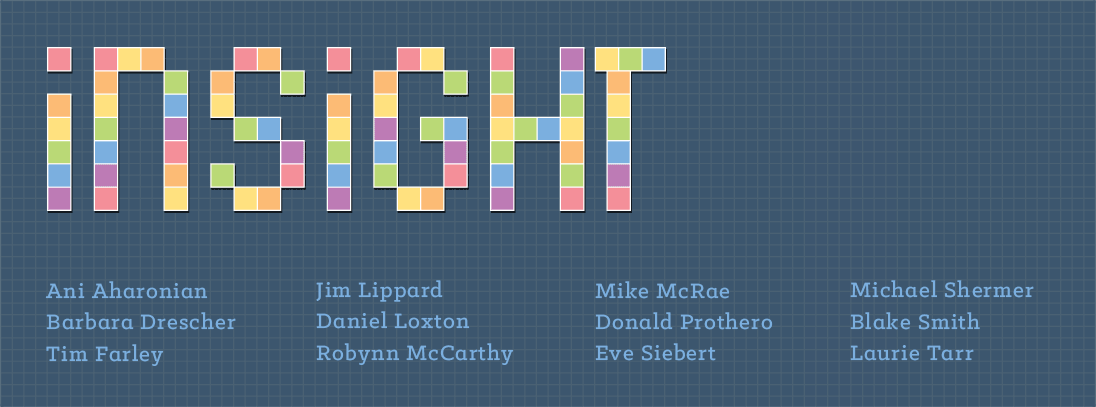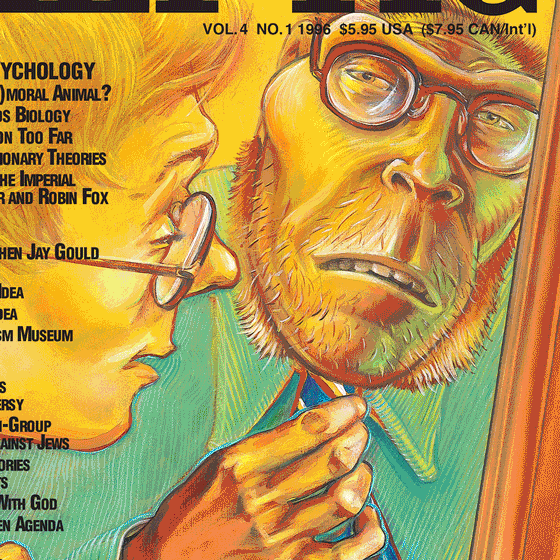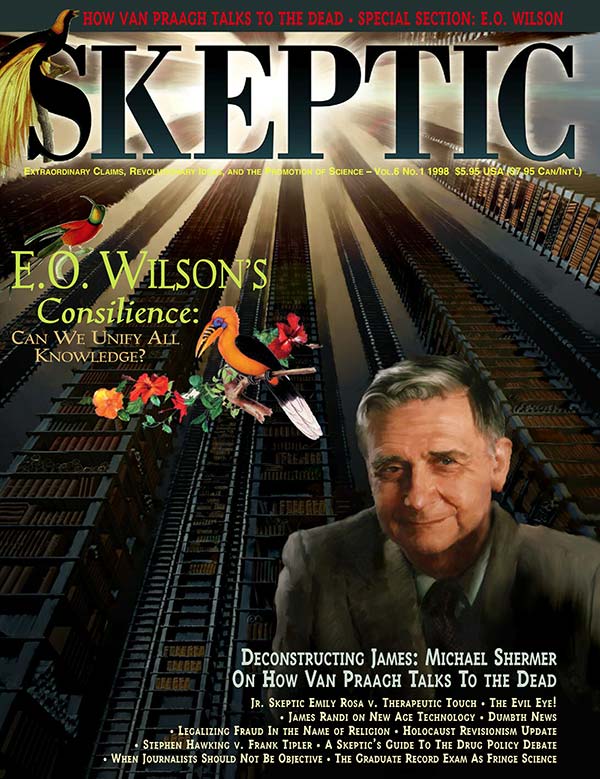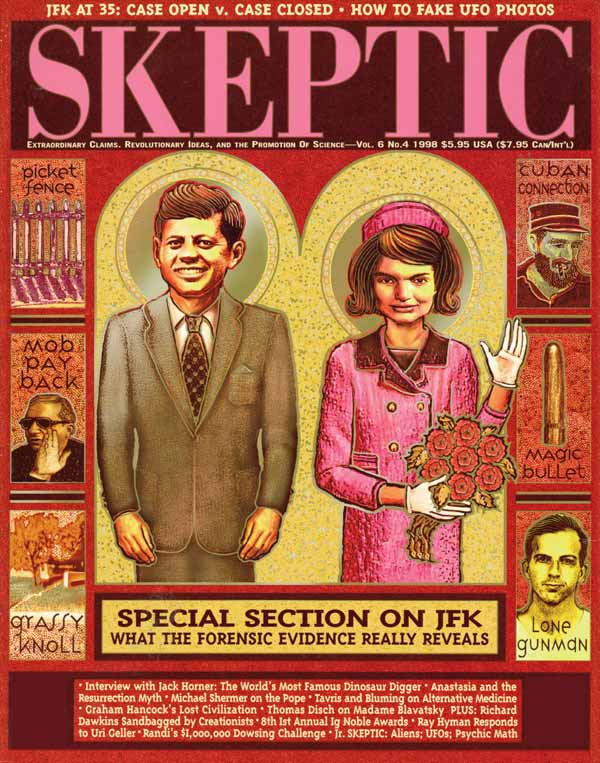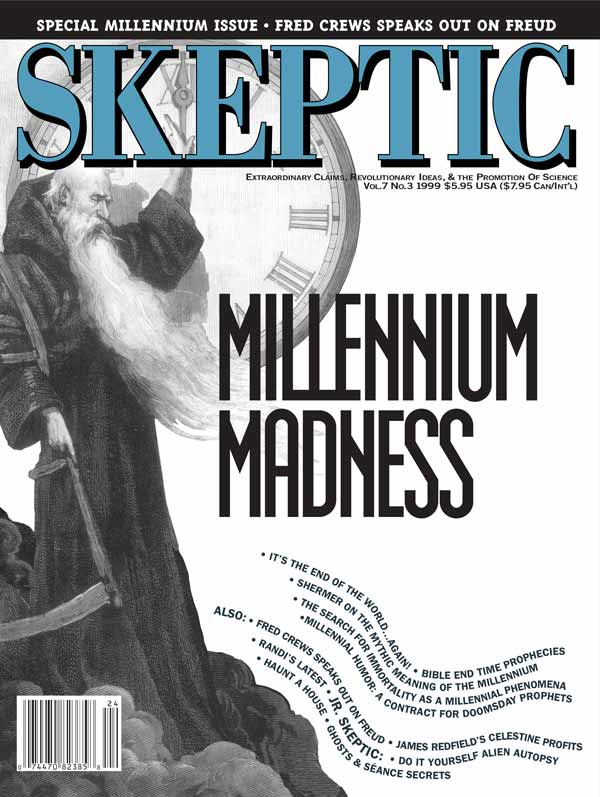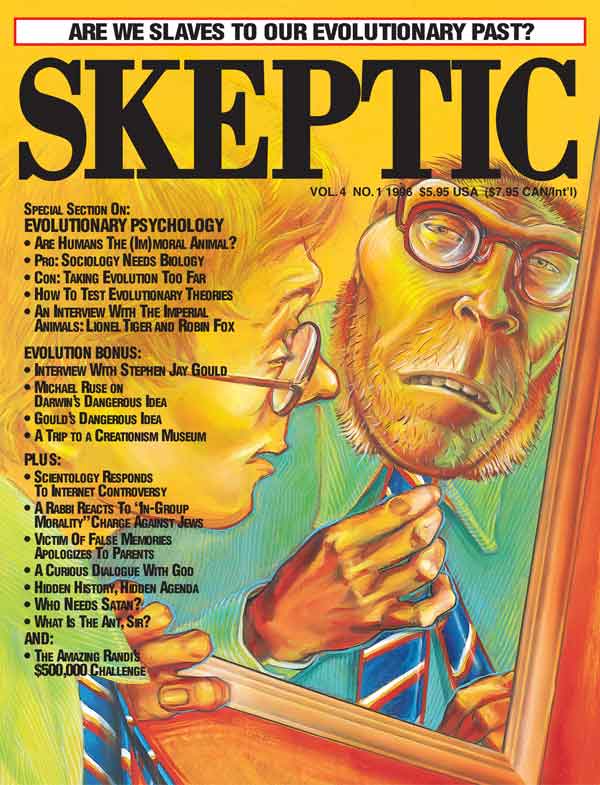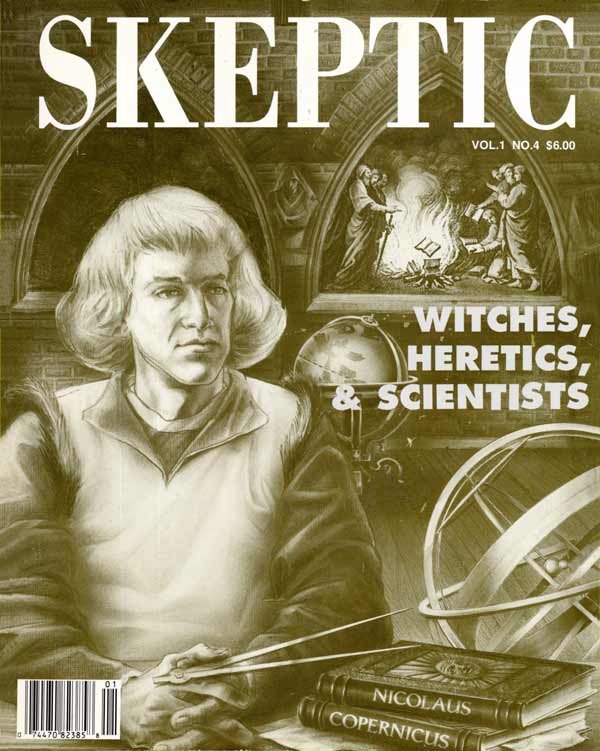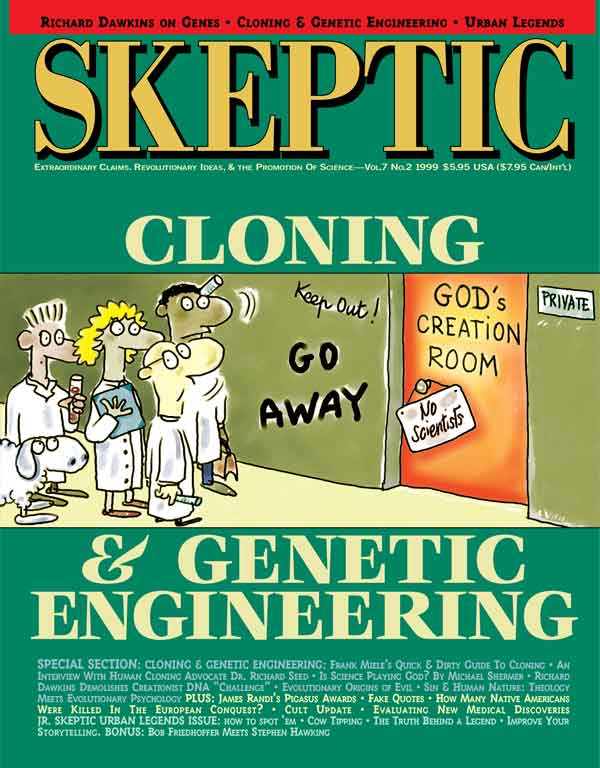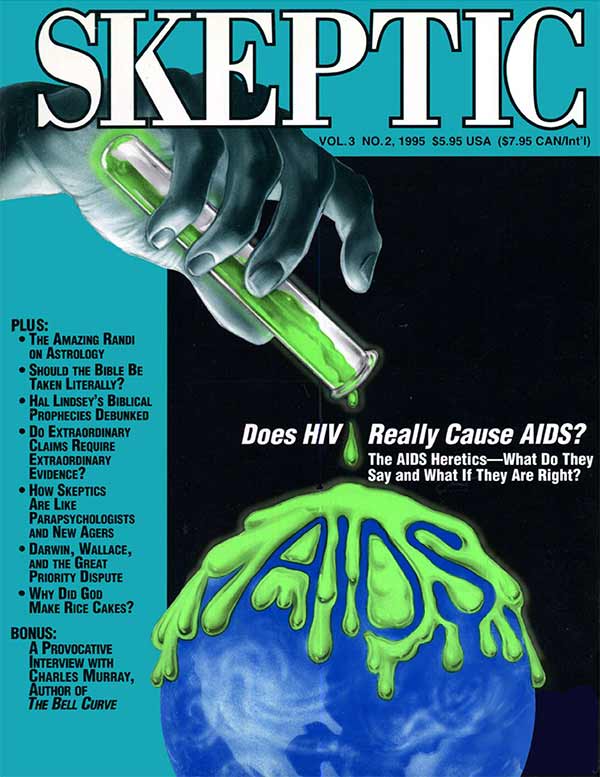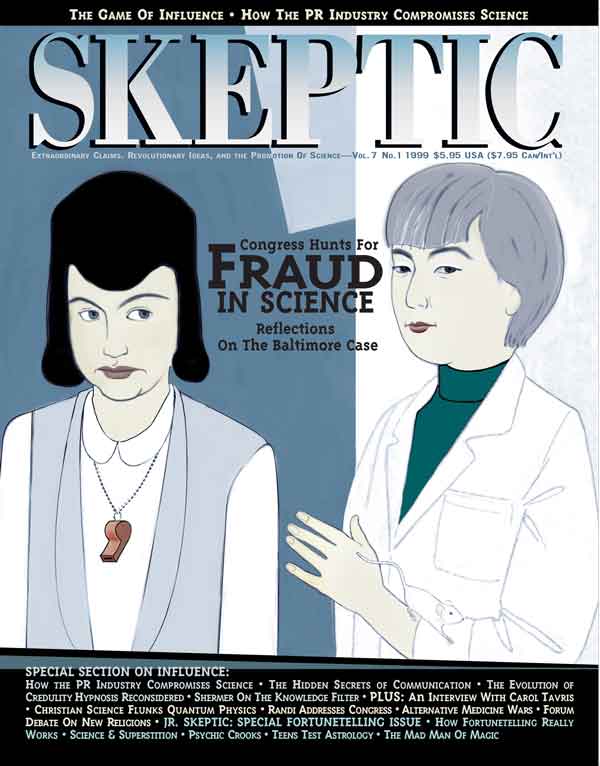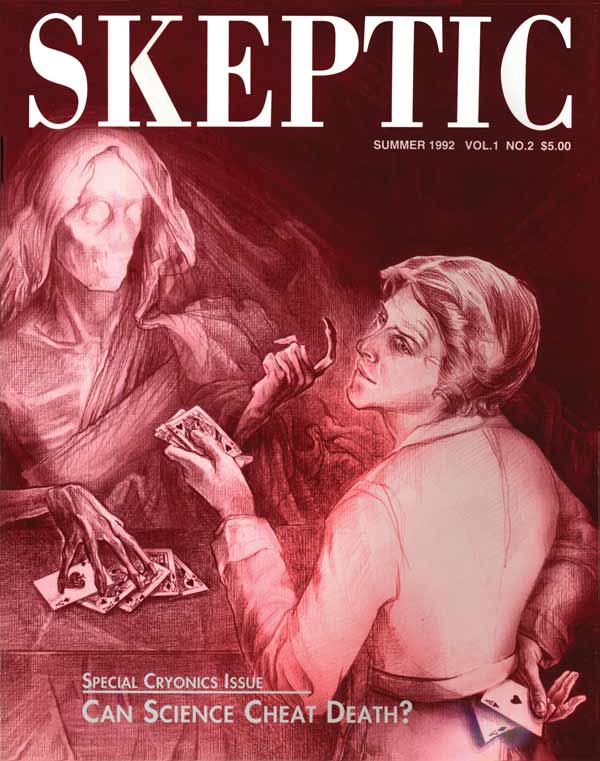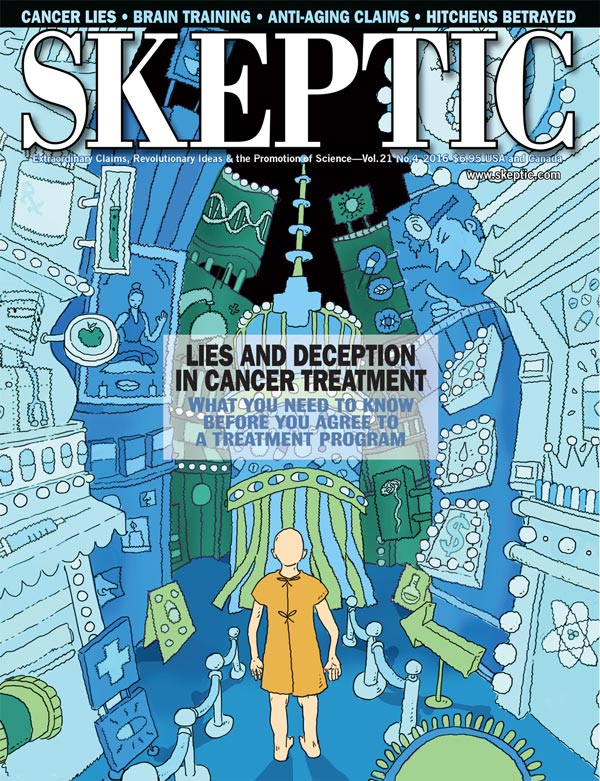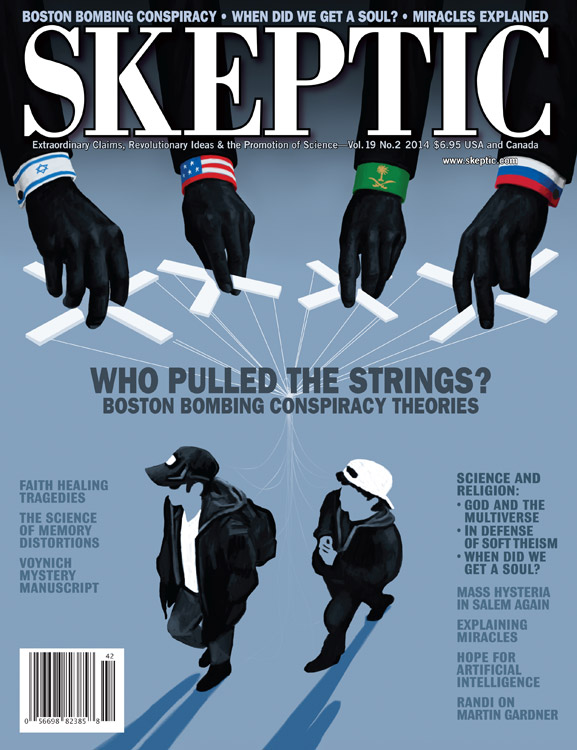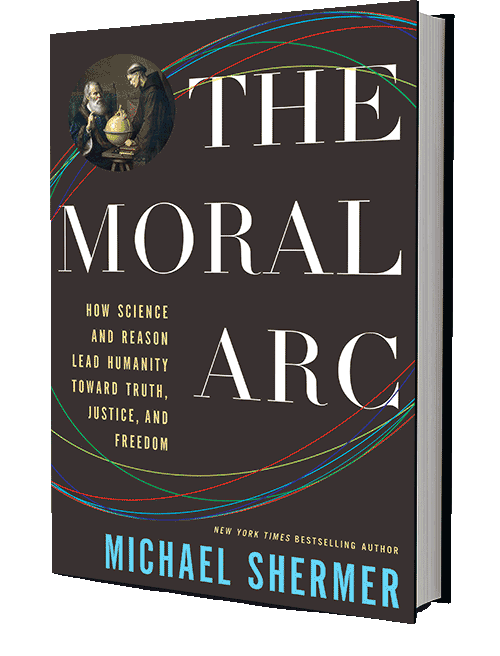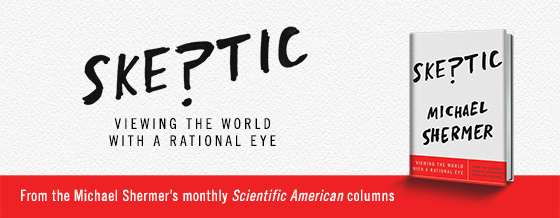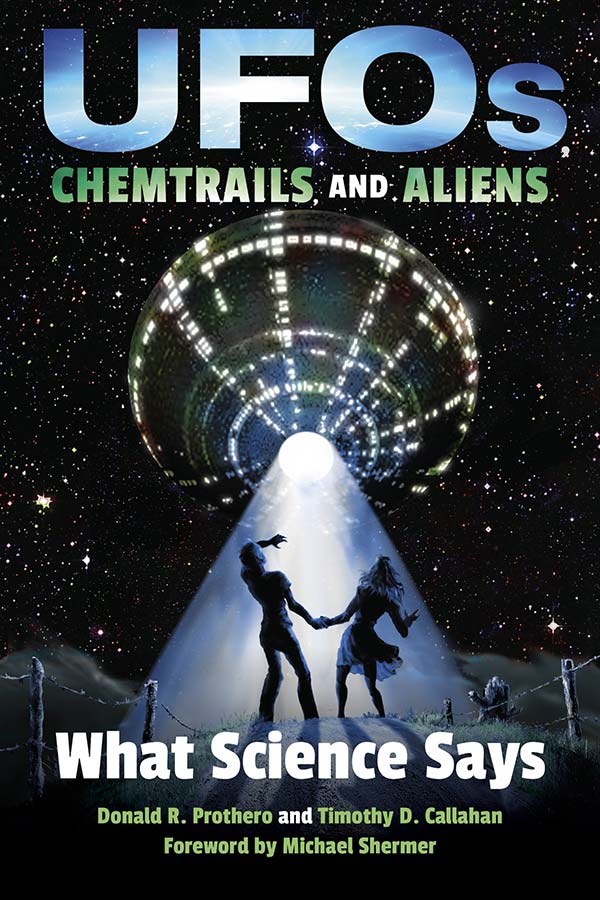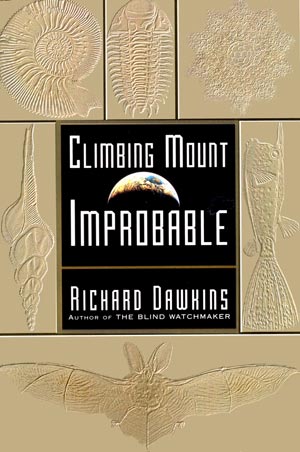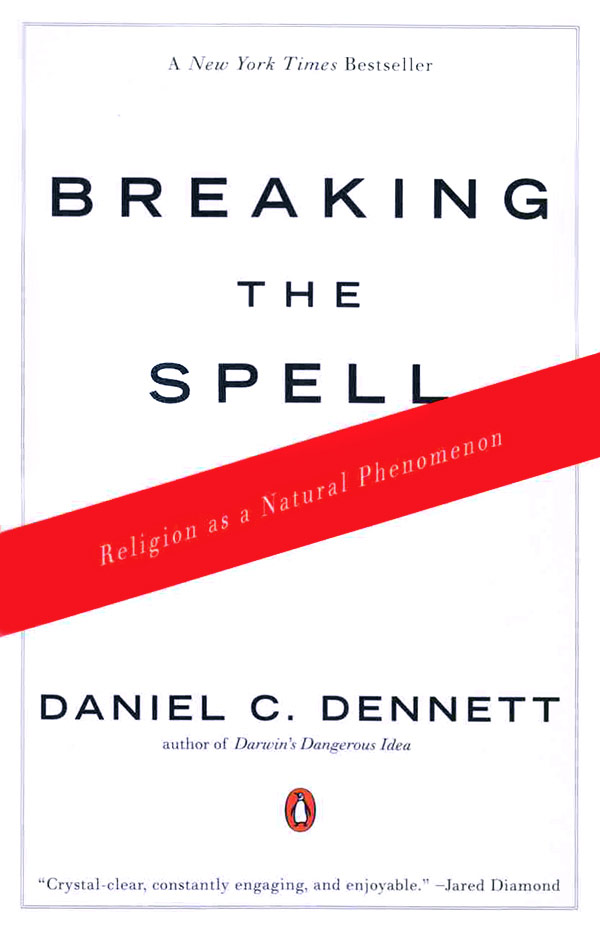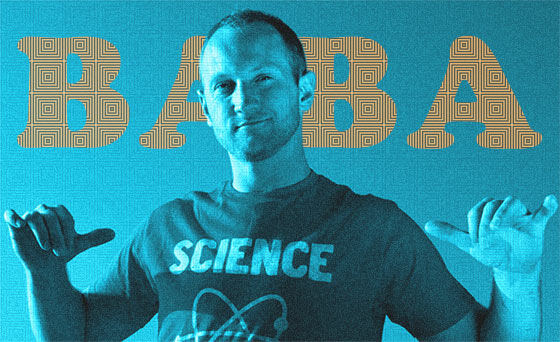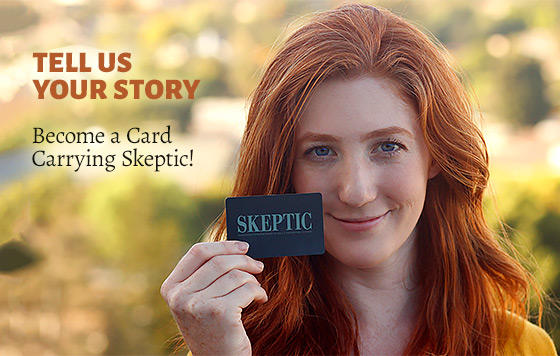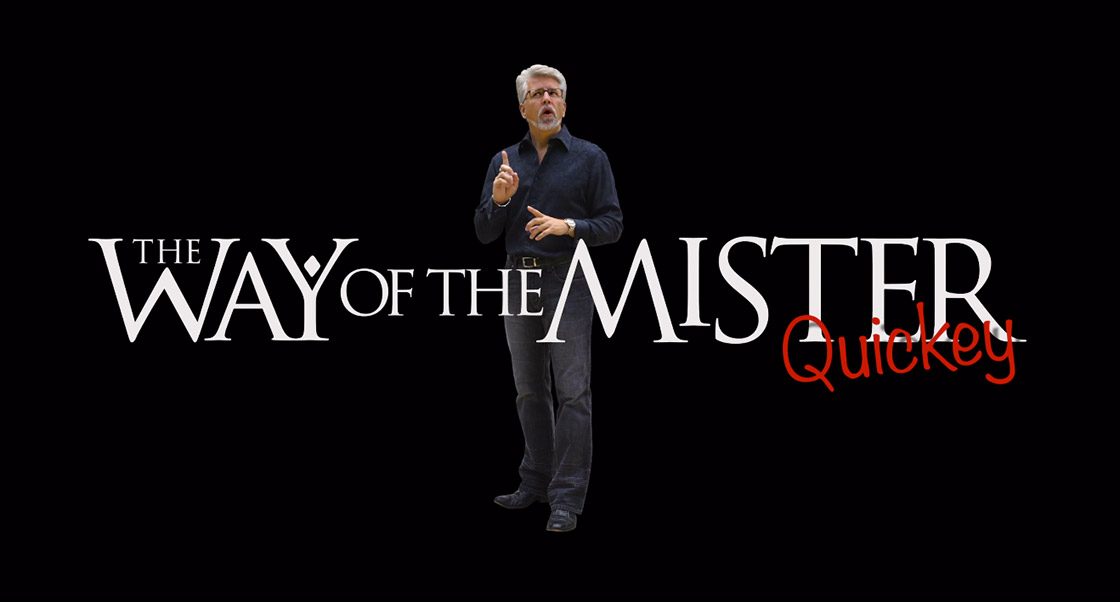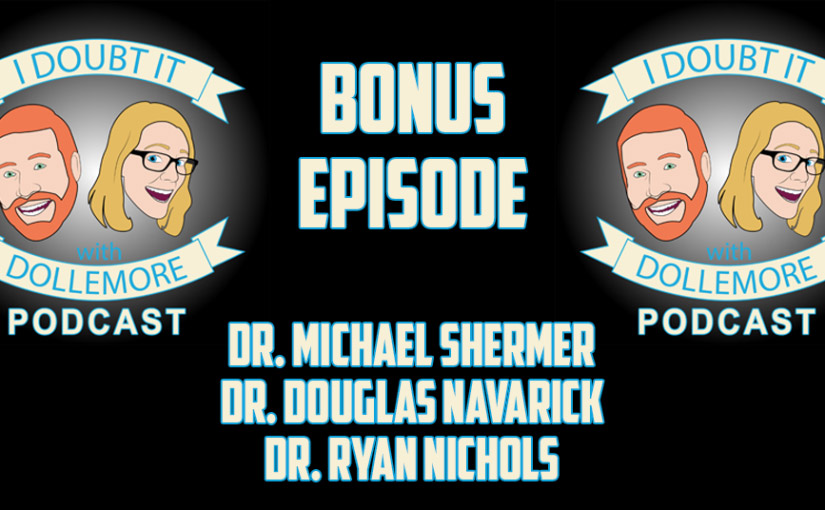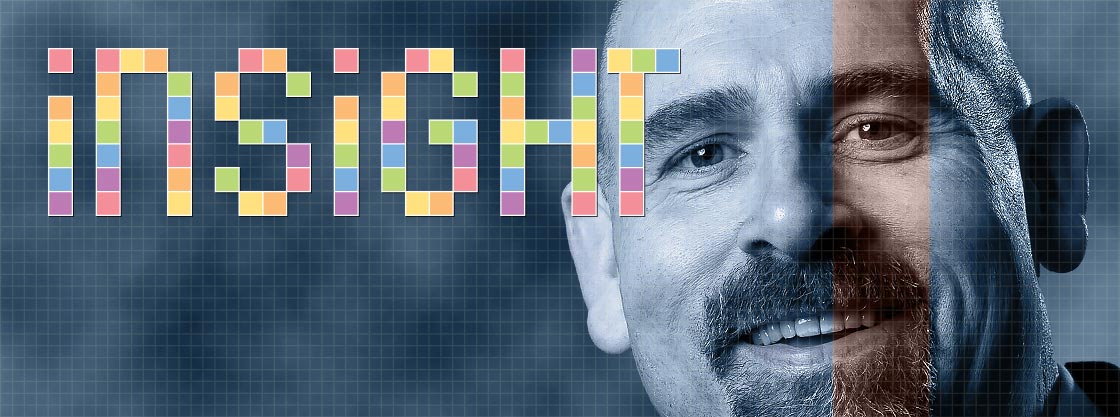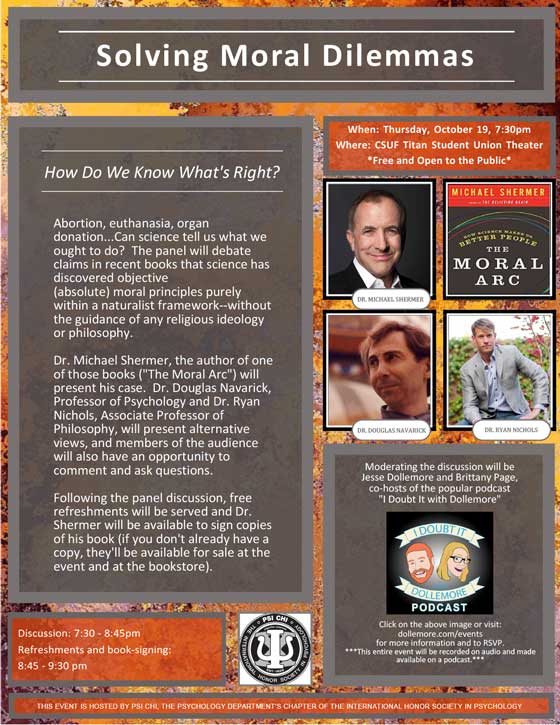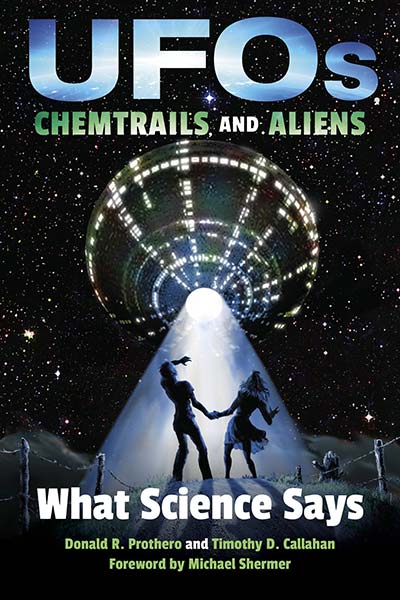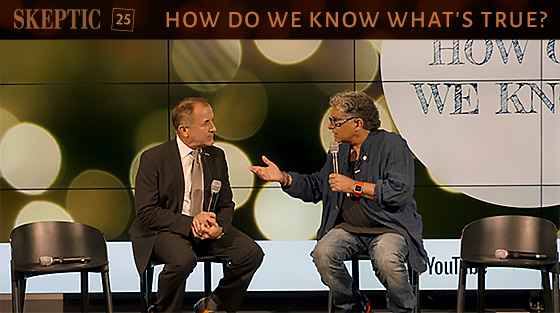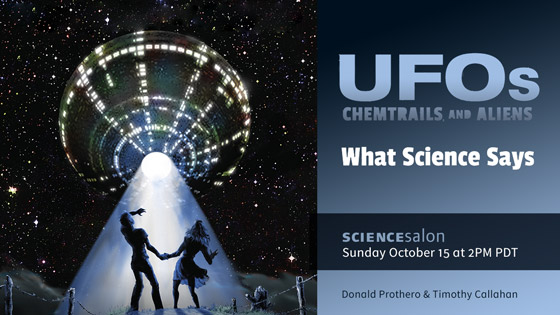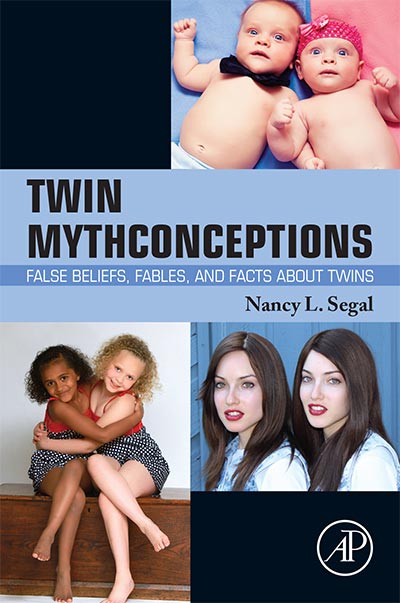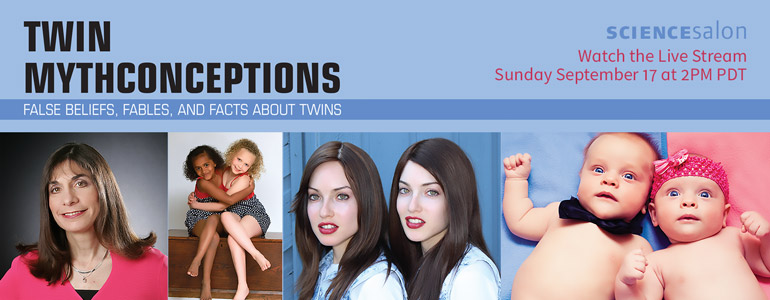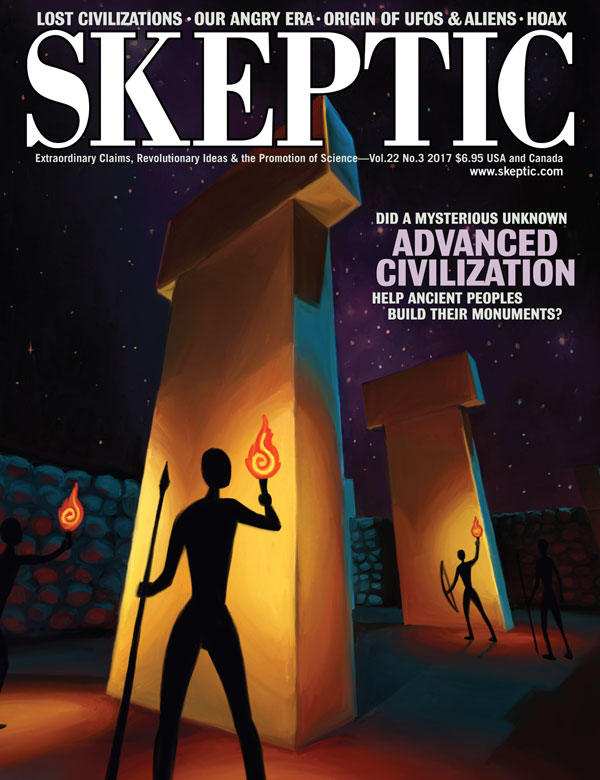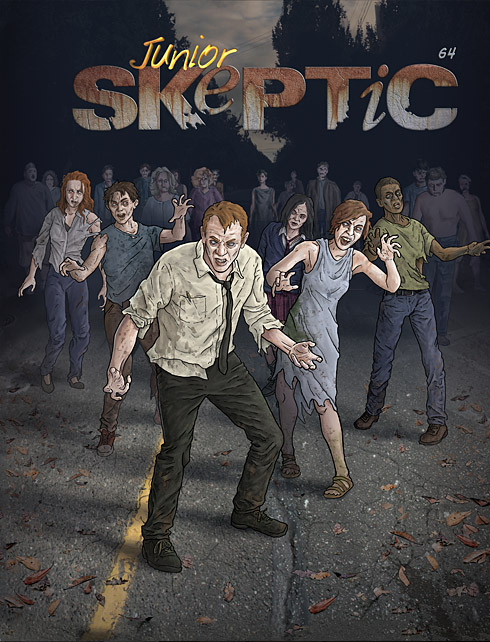Skeptic Six-Day Sale (25% Off, Now Thru Cyber Monday)
In this week’s eSkeptic:
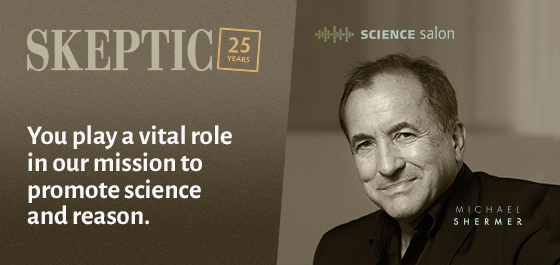
25 YEARS STRONG
Your ongoing patronage will help ensure that sound scientific viewpoints are heard worldwide.
2017 was another banner year for science, skepticism, and critical thinking. We celebrated our 25th anniversary with a spectacular event in New York City that featured our Executive Director Dr. Michael Shermer and a number of skeptical and scientific Internet celebrities including the ASAP Science guys, the science rapper Baba Brinkman, neuroscientist Dr. Heather Berlin, pop star Michael Posner, magician Prakash Puru, The Thinking Atheist podcast host Seth Andrews, and others. Thanks to your continuing support we are looking forward to 2018 and are pleased to tell you about some of the great success we have had with new projects launched in 2017. Click the button below to read the 4-page update from Michael Shermer, the Skeptics Society’s Executive Director.
Ways to Make Your Tax-Deductible Donations
You can make a donation online using your credit card, or by downloading a printable donation card to make your donation by cheque in the mail. You may also make a donation by calling 1-626-794-3119. The Skeptics Society is US 501(c)(3) nonprofit educational organization. Donations are tax deductible.
NOW THROUGH CYBER MONDAY
25% off almost everything in store
It’s our best sale of the year, on now through Cyber Monday. SAVE 25% on almost everything at Shop Skeptic, including: books, t-shirts, stickers, lapel pins, and print subscriptions. The only products that aren’t 25% off are back issues of Skeptic magazine (print edition), which are over 80% off! See details further down the page. Shop now.
Shipping not included, while supplies last. Sale ends at 23:59:59 Monday, November 27, 2017, PST.
ORDER FOR CHRISTMAS DELIVERY
Order by December 6 for shipments outside the US.
Order by December 13 for shipments inside the US.
See our Holiday Shipping page for complete details.
NOW THROUGH CYBER MONDAY
25% off digital subscriptions & back issues
SAVE 25% on digital subscriptions and back issues at PocketMags.com/Skeptic-Magazine. Click the button below, add a digital subscription or back issue(s) to your shopping cart, and enter promocode ‘SKEPTIC25’ at checkout. After you’ve made your purchase(s), your PocketMags account allows you to synchronize your purchases to your phone or tablet by signing in to the Skeptic Magazine App (or PocketMags App) using the same username and password you used to make your purchase(s) on PocketMags.com. Questions? Email the Skeptic Webmaster.
UNPRECEDENTED SAVINGS
$1 or less per issue. Over 80% off!
(plus shipping)
Save 80–90% on printed back issues of Skeptic magazine, now through Cyber Monday. At 50¢–$1 per issue (depending on quantity purchased), it’s never been a better time to complete your collection of Skeptic magazine with unprecendented savings during our inventory blowout!
INVENTORY BLOWOUT
Buy more. Save more (while quantities last!)
We need to make room in our warehouse. So, we are practically giving away printed back issues of Skeptic magazine for as low as 50¢ per issue (i.e. when you buy 50 issues at a savings of a whopping $275)! The more you buy, the bigger the discount:
- 1 for $1
- 5 for $4 (80¢ ea.)
- 10 for $7 (70¢ ea.)
- 25 for $15 (60¢ ea. — That’s a $135 savings!)
- 50 for $25 (50¢ ea. — That’s a $275 savings!)
Shipping not included. Shipping will be calculated based on weight & destination and added to your total at checkout. While Supplies Last. Back issues that are no longer available in print may be available in digital format (except for a couple of our earliest volumes, which will hopefully be digitized next year.)
Stephen Jay Gould called Skeptic magazine “The best journal in the field.” For 25 years, our definitive skeptical journal has promoted science and reason. Our in-depth articles explore and inform. Buy it. Read it. Share it. Help us make the world a more rational place.
Browse all Back Issues
on sale for $1 or less!
MAY WE SUGGEST
these informative and in-depth issues…
Science & Society
E.O. Wilson: Can We Unify All Knowledge?; Deconstructing James Van Praagh Talking to the Dead; Emily Rosa Tests Therapeutic Touch; The Ancient Evil Eye; James Randi on New Age Tech; Legalizing Fraud in the Name of Religion; Holocaust Revisionism; Stephen Hawking v. Frank Tipler; Skeptic’s Guide to the Drug Policy Debate; Objectivity in Journalism; Graduate Record Exam Fringe Science…
John F. Kennedy
JFK Facts and Fictions; JFK Case Still Open: Skepticism and the Assassination of JFK; JFK Assassination Science; James Randi on Dowsing; Steven T. Asma on Critical Thinking; The Case For and Against God: A Forum Exchange; The Lost World: of Jack Horner An Interview with the World’s Most Famous Dinosaur Digger; Anastasia: Miraculous Survival Myth; Aliens Among Us?; Psychic Math!; How to Fake UFO Photo…
Pseudomedicine
Life After False Memory Syndrome; The Mattoon Phantom Gasser Mass Hysteria; Why Should Skeptics Understand Religion?; Skeptical Perspectives: A Heretic-Scientist Among the Spiritualists; Homeopathy; Spiritual Belief Systems Try to Compete as Alternatives to Scientific Health Care; Therapeutic Touch; Leftist Science; Star Trek’s Meaning; Liquefying “Blood” …
Millennium Madness
A Critical Analysis of James Redfield and The Celestine Prophesy; Search for Immortality; The Alpha and the Omega The Creation and the End in Biblical Eschatology ; Celestine Prophesy; The Fire That Will Cleanse: Millennial Meanings and the End of the World ; That’s All Folks! It’s the End of the World … Again; Apocalypse Never The Search for Immortality as Millennial Phenomena; Myth and Science; Political Extremism; Autopsy Aliens…
Evolutionary Psychology
Quadro Tracker Dowsing Stick, Tested; Jehovah’s Witnesses/End of World; Physics; McIver Guide to Evolutionary Psychology/Nature of Human Nature; Salter Evolutionary Psychology as Protoscience; Critical Analysis of Evolutionary Psychology; Interview: Stephen Jay Gould; Gould’s Dangerous Idea: Contingency/Necessity/Nature of History; Reviews: Darwin’s Dangerous Idea; The Origin of Satan; The Final Superstition…
Witches, Heretics & Scientists
Special Section: The Price of Intolerance; Spirits, Witches & Science: Why the Rise of Science Encouraged Belief in the Supernatural in 17th-Century England; Ideological Immune System: Resistance to New Ideas in Science; Psychology of Resistance to the Heretical-Science of Copernicus; Edgar Cayce Foundation Responds to a Skeptical Critique and we reply; It’s Baaack: The Nature-Nurture Debate…
Environmental Science
Ecologists vs. Economists: A Quick & Dirty Guide to the Environmental Debate: Is Environmental Science polluted by Politics?; The Beautiful People Myth; Population Risk Assesment; The Not-So-Wise-Use Movement; Julian Simon Slams Eco-Crybabies; Top Scientists’ Eco-warning; Fred Crews on Modern American Witch Hunters; Ancient Astro-NOTS; Murky Origins of Hale-Bopp UFO Fiasco; Human Magnets; Dowsing; Futurists…
Cloning & Genetic Engineering
Cloning Science & Ethics; Science’s Moral Limits; How Evolution Increases Information in the Genome; Group Selection & Origins of Evil; Historical Perspective on Theology & Evolutionary Psychology; Urban Legends; Hawking Expanding Universe Trick; Deconstructing JFK: Assassination Debate Continues; De-Population Myths; Is Anybody Out There?; Freethinkers, Fundamentalists, Fake Quotes …
AIDS
Does HIV Really Cause AIDS? A Case Study in Skepticism Taken Too Far; AIDS Part I: The Skeptics and Their Claims; Part II: How Skepticism Went Astray; Part III Lessons on How Science Works; An interview with the author of The Bell Curve, Charles Murray; Alfred Russel Wallace, Charles Darwin, and the Resolution of a Scientific Priority Dispute; The Question All Skeptics are Asking: Why Did God Make Rice Cakes?…
Gender Differences
What Science Says and Why it’s Mostly Wrong; Gender and the Paranormal; What Science Says About the Soul; Interview with Controversial Anthropologist Napoleon Chagnon; Is Earth’s Magnetic Field Reversal Dangerous?; Scientology Self Help Handbook; Can We Trust Science Media Reports?; Why The Universe Exists; Skeptics in Film; Witchcraft Ceremony; Junior Skeptic: Alien Invaders!…
The Game of Influence
The Game of Influence: Understanding the Hidden Dynamics of Communication; Selection for Credulity A Biologist’s View of Belief; Legitimatizing Psychology’s Prodigal Son: Re-considering Hypnosis for the 21st Century; How the Public Relations Industry Compromises Democracy; The Knowledge Filter Reality Must Take Precedence in the Search for Truth…
Cryonics: Can Science Cheat Death?
Can Science Cheat Death?; Technical Aspects; The Society for the Recovery of Persons Apparently Dead: History of Resuscitation; Basic Q&A on Cryonics from Alcor Life Extension Foundation; Physicist in the White House?; Black Holes; Acupuncturists and Chiropractors Fined; Secular Alcohol Treatment; Laws of Robotics; Establishing a Miracle; Use & Abuse of Statistics in the “Real World”…
Deception in Cancer Treatment
Deceptive Cancer-care Industry Marketing; Amityville Hoax at 40; Alien Skulls?; Meaning Behind the Nazca Geoglyphs; Clown Sightings Rattle Nerves; Case for a Galactic Defense System; Is “Spirituality” Meaningless?; Are We Living in a Computer Simulation?; One of the Most Fundamental Sources of Error in Human Judgment; Thinking Critically about Public Discourse; Anti-Aging Claims…
Boston Bombing Conspiracy Theories
Conspiracy in Boston: Disentangling Boston Marathon Bombing Conspiracy Theories; Miracle of Large Numbers Explains Seemingly Miraculous Events; Reasons for Hope in the Science of Artificial Intelligence; Faith Healing Tragedies; The Science of Memory and the Dylan Farrow/Woody Allen Case; Photographing Phantoms; Strange and Unusual Religious Beliefs and Practices in the United States; Cosmos: A Spacetime Odyssey…
Remember, the more you buy, the bigger the discount:
- 1 for $1
- 5 for $4 (80¢ ea.)
- 10 for $7 (70¢ ea.)
- 25 for $15 (60¢ ea. — That’s a $135 savings!)
- 50 for $25 (50¢ ea. — That’s a $275 savings!)
Browse all Back Issues
on sale for $1 or less!
Below, you’ll find a few books we recommend for your library. These also make great gifts!
AUTOGRAPHED HARDCOVER, 1st EDITION
How Science and Reason Lead Humanity toward Truth, Justice, and Freedom
Get a 1st edition, autographed, hardcover copy of Dr. Michael Shermer’s The Moral Arc: How Science and Reason Lead Humanity toward Truth, Justice, and Freedom for only $9.50, plus shipping (while quantities last). In this book about moral progress, Shermer demonstrates, through extensive data and heroic stories, that the arc of the moral universe bends toward truth, justice, and freedom, and that we are living in the most moral period of our species’ history.
Praise for the book
A thrilling and fascinating book, which could change your view of human history and human destiny.
In these cynical times, where right and left foresee disaster and despair (albeit for different reasons), Shermer’s monumental opus, spanning centuries, nations, and cultures, is bound to provoke debate and open minds.
Shermer’s thought-provoking, multidisciplinary book will engage anyone who wishes to understand rationalism as a force for morality.
AUTOGRAPHED HARDCOVER
75 Collected essays from bestselling author Michael Shermer’s celebrated columns in Scientific American
Reg. $28. NOW $21
For fifteen years, bestselling author Michael Shermer has written a column in Scientific American magazine that synthesizes scientific concepts and theory for a general audience. His trademark combination of deep scientific understanding and entertaining writing style has thrilled his huge and devoted audience for years. Now, in SKE?TIC, seventy-five of these columns are available together for the first time; a welcome addition for his fans and a stimulating introduction for new readers.
Praise for the book
Dense with facts, convincing arguments, and curious statistics, this is an ingenious collection of light entertainment for readers who believe that explaining stuff is a good idea.
Shermer makes a strong case for the value of the scientific endeavor and the power of rational thinking in 75 brief essays…. Each entry is insightful, informative, and entertaining.
Michael Shermer is a beacon of reason in an ocean of irrationailty.
UFOs, Chemtrails, and Aliens: What Science Says
UFOs. Aliens. Strange crop circles. Giant figures scratched in the desert surface along the coast of Peru. The amazing alignment of the pyramids. Strange lines of clouds in the sky. Paranormal belief is alive and well in American. Donald Prothero and Tim Callahan explore why such demonstrably false beliefs thrive despite decades of education and scientific debunking. Employing the standards of scientific evidence, the authors discuss the reliability of eyewitness testimony, and the psychology of belief and conspiratorial thinking.
The New Age: Notes of a Fringe Watcher
The New Yorker calls it, “Fair, witty appraisal of cranks, quacks, and quackeries of science and pseudoscience … A very able and even-tempered presentation.” This book is a classic of skeptical literature filled with thirty-three diverse chapters: a bountiful offering of the delightful drollery and horse sense that has made Martin Gardner the undisputed dean of the critics of pseudoscience. It is also a quick way to get up to speed on many topics. Gardner is not afraid to examine the process of critical examination itself.
Climbing Mount Improbable
A brilliant book celebrating improbability as the engine that drives life, by the acclaimed author of The Selfish Gene, The Blind Watchmaker, and The God Delusion. The human eye is so complex and works so precisely that it appears to be the product of design. How could such an intricate object have come about by chance? In writing that the New York Times called “a masterpiece”—Richard Dawkins builds a carefully reasoned and illustrated argument for evolutionary adaptation as the mechanism for life on earth.
Breaking the Spell
In this New York Times Bestseller (and a definitive work on religion), Daniel Dennett (one of the “Four Horsemen” and a world-famous philosopher) asks: Is religion a product of blind evolutionary instinct or rational choice? Is it truly the best way to live a moral life? Ranging through biology, history, and psychology, Dennett charts religion’s evolution from “wild” folk belief to “domesticated” dogma.
STICK IT TO ’EM
Skeptic Lapel Pin
Reg. $10. NOW $7.50
We’d like to see this lapel pin become world-famous, and we need your help to make that happen! Every skeptic (and his/her best friends) should have one of these lapel pins. They feature elegant gold-colored SKEPTIC letters, with a contrasting black background. They’re a great size for a lapel or tie-tack — about 25mm × 6mm (1″ × .25″). The pin comes in a classy little plastic box suitable for gift-giving. At this price, why not get one for every jacket you own!
MORE IN STORE!
Shop our entire online selection and save now through Cyber Monday
Dr. Robert Trivers — Evolutionary Theory & Human Nature
Dr. Robert Trivers and Dr. Michael Shermer have a lively conversation on everything from evolutionary theory and human nature to how to win a knife fight and Trivers’ membership in the Black Panthers. Don’t miss this engaging exchange with one of the most interesting scientists of the past half century.
This Science Salon followed Dr. Robert Trivers’ lecture on ‘The Evolutionary Genetics of Honor Killings,’ which he gave in Dr. Michael Shermer’s Skepticism 101 course at Chapman University on Thursday November 16, 2017:
eSkeptic for November 15, 2017
In this week’s eSkeptic:
- Shermer Shreds: Mass Public Shootings & Gun Violence: Part I
- Baba Brinkman’s Skeptic Rap: Rap Artist Performs Science-Based Hip-Hop
- Tell Us Your Story!: How Brian Brushwood Became a Card-Carrying Skeptic
- MonsterTalk Episode 141: The Crypto-Kid: Interview with Colin Schneider
- Feature: The Wizardry of Sigmund Freud
SHERMER SHREDS
Mass Public Shootings & Gun Violence: Part I
At 59 dead and over 540 wounded, the Las Vegas massacre that took place on October 1, 2017 is now the worse mass public shooting in U.S. history.
As is usually the case with such gun-related tragedies, within hours social media and political punditry was abuzz with talk of gun control and Second Amendment rights, with both the left and the right marshaling their data and arguments. The two most common arguments made in defense of gun ownership are (1) self protection and (2) as a bulwark against tyranny.
In this video, Michael Shermer “shreds” these ideas with skeptical scrutiny.
BABA BRINKMAN’S SKEPTIC RAP
Rap Artist Performs Science-Based Hip-Hop
Baba Brinkman is a Canadian rap artist based in New York. He is best known for his “Rap Guide” series of science-based hip-hop albums and theatres shows, including Rap Guides to Evolution, Climate Change, and Religion.
The world premiere of this rap was performed at a live variety science show hosted by Dr. Michael Shermer, in partnership with YouTube Space NY in late September 2017, celebrating 25 years of Skeptic magazine and the Skeptics Society combating ‘fake news.’ The event explored the question: ‘How Can We Know What’s True?’.
A NEW STORY!
How Brian Brushwood Became a Card-Carrying Skeptic
As we announced a few weeks ago in eSkeptic, we asked several friends to tell us about those “aha!” moments that led to their becoming skeptical thinkers. As promised, here is another one of their incredible stories on YouTube. Enjoy!
American magician, podcaster, author, lecturer, and comedian, Brian Brushwood is the host of Scam School for Discovery, Hacking the System for National Geographic, and co-host of The Modern Rogue. He is the author of several books including: Scam School: Your Guide to Scoring Free Drinks, Doing Magic & Becoming the Life of the Party, and The Professional’s Guide to Fire Eating.
TELL US YOUR STORY!
Tell us your story and become a card-carrying skeptic! Thank you for being a part of our first 25 years. We look forward to seeing you over the next 25. —SKEPTIC
The Crypto-Kid
MONSTERTALK EPISODE 141
In this episode of MonsterTalk, we interview cryptozoology enthusiast Colin Schneider, a young and enthusiastic researcher of Fortean and paranormal topics about his research into animal exsanguination. It’s a fun discussion of the field of cryptozoology, the disturbing topic of animal mutilation and the work done by the British organization, the Center for Fortean Zoology.
Get the MonsterTalk Podcast App and enjoy the science show about monsters on your handheld devices! Available for iOS, Android, and Windows. Subscribe to MonsterTalk for free on iTunes.
![Sigmund Freud (1926). Photo by Ferdinand Schmutzer [Public domain], via Wikimedia Commons (https://commons.wikimedia.org/wiki/File%3ASigmund_Freud_1926.jpg)](https://www.skeptic.com/eskeptic/2017/images/17-11-15/Sigmund-Freud-1926-by-Ferdinand-Schmutzer-with-signature-added.jpg)
In this week’s eSkeptic, Margret Schaefer reviews Freud: The Making of an Illusion, in which its author, Frederick Crews, convincingly argues that Freud constructed psychoanalysis on a fraudulent foundation. How did Freud convince so many people of the correctness and the profundity of his theory?
The Wizardry of Freud
by Margret Schaefer
“Clear evidence of falsification of data should now close the door on this damaging claim.”
The above is from a 2011 British Medical Journal article about Andrew Wakefield, the British physician whose “discovery” of a link between vaccination and autism fueled a world wide anti-vaccination movement. Since its publication in 1998, the paper’s results were contradicted by many reputable scientific studies, and in 2011 Wakefield’s work was proved to be not only bad science but a fraud as well: a British court found him guilty of dishonestly misrepresenting his data, removed him from the roster of the British Medical Society, and disbarred him from practice.
In his new book, Freud: The Making of an Illusion, Frederick Crews presents a Freud who was just such a fraud and who deserves the same fate. This is not the first time that Crews, a bona fide skeptic whose last book, Follies of the Wise: Dissenting Essays (2007), was reviewed in the pages of this journal, has written critically about Freud. Crews had been drawn to psychoanalysis himself (disclosure: this reviewer was, too) in the 1960s and early 1970s when, along with the late Norman Holland, he pretty much created the field of psychoanalytic literary criticism. But a prestigious fellowship to the Stanford Center for Advanced Study in the Behavioral Sciences (he was a professor of English at UC Berkeley at the time) gave him time to delve deeper into Freud, and convinced him instead that psychoanalysis was unscientific and untenable. Since then he has contributed to the growing skeptical scholarly and historical scholarship on Freud.
Psychoanalysis is not only pseudoscience (as most philosophers of science agree, though for different reasons), but “the queen of pseudosciences”.
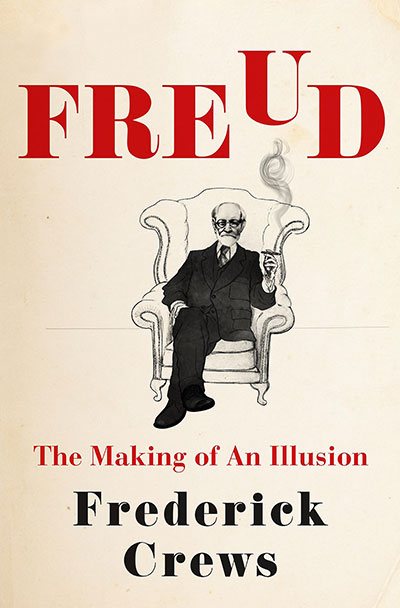
Philosophers of science have indicted key concepts of Freud’s psychoanalysis such as “free association,” “repression,” and “resistance” as circular and fatally flawed by confirmation bias. Historians have tracked down the actual patients whose treatment served Freud as evidence for his theories and have sought to place Freud and his theories in the historical and cultural context of his time. Crews—to his own surprise—became well known as a major, if not the major, critic of Freud in the public eye because of a series of articles he published in the New York Review of Books in the 1990s. For Crews is that now all too rare and rapidly disappearing creature—the public intellectual—who is able to explain and make accessible an otherwise unwieldy amount of erudite scholarship in clear, elegant, and jargon-free prose. Defenders of Freud have sought to discredit him as a “Freud basher,” thereby continuing the (not so honorable) tradition that Freud began of questioning the motives of a skeptic and attributing it to “resistance” instead of answering his objections. […]
The Wizardry of Freud
“Clear evidence of falsification of data should now close the door on this damaging claim.”
The above is from a 2011 British Medical Journal article about Andrew Wakefield, the British physician whose “discovery” of a link between vaccination and autism fueled a world wide anti-vaccination movement. Since its publication in 1998, the paper’s results were contradicted by many reputable scientific studies, and in 2011 Wakefield’s work was proved to be not only bad science but a fraud as well: a British court found him guilty of dishonestly misrepresenting his data, removed him from the roster of the British Medical Society, and disbarred him from practice.
In his new book, Freud: The Making of an Illusion, Frederick Crews presents a Freud who was just such a fraud and who deserves the same fate. This is not the first time that Crews, a bona fide skeptic whose last book, Follies of the Wise: Dissenting Essays (2007), was reviewed in the pages of this journal, has written critically about Freud. Crews had been drawn to psychoanalysis himself (disclosure: this reviewer was, too) in the 1960s and early 1970s when, along with the late Norman Holland, he pretty much created the field of psychoanalytic literary criticism. But a prestigious fellowship to the Stanford Center for Advanced Study in the Behavioral Sciences (he was a professor of English at UC Berkeley at the time) gave him time to delve deeper into Freud, and convinced him instead that psychoanalysis was unscientific and untenable. Since then he has contributed to the growing skeptical scholarly and historical scholarship on Freud.
Philosophers of science have indicted key concepts of Freud’s psychoanalysis such as “free association,” “repression,” and “resistance” as circular and fatally flawed by confirmation bias. Historians have tracked down the actual patients whose treatment served Freud as evidence for his theories and have sought to place Freud and his theories in the historical and cultural context of his time. Crews—to his own surprise—became well known as a major, if not the major, critic of Freud in the public eye because of a series of articles he published in the New York Review of Books in the 1990s. For Crews is that now all too rare and rapidly disappearing creature—the public intellectual—who is able to explain and make accessible an otherwise unwieldy amount of erudite scholarship in clear, elegant, and jargon-free prose. Defenders of Freud have sought to discredit him as a “Freud basher,” thereby continuing the (not so honorable) tradition that Freud began of questioning the motives of a skeptic and attributing it to CONTINUE READING THIS POST…
TAGS: fraud, pseudoscience, psychoanalysis, Sigmund FreudWhy We Should Be Concerned About Artificial Superintelligence
The human brain isn’t magic; nor are the problem-solving abilities our brains possess. They are, however, still poorly understood. If there’s nothing magical about our brains or essential about the carbon atoms that make them up, then we can imagine eventually building machines that possess all the same cognitive abilities we do. Despite the recent advances in the field of artificial intelligence, it is still unclear how we might achieve this feat, how many pieces of the puzzle are still missing, and what the consequences might be when we do. There are, I will argue, good reasons to be concerned about AI.
The Capabilities Challenge
While we lack a robust and general theory of intelligence of the kind that would tell us how to build intelligence from scratch, we aren’t completely in the dark. We can still make some predictions, especially if we focus on the consequences of capabilities instead of their construction. If we define intelligence as the general ability to figure out solutions to a variety of problems or identify good policies for achieving a variety of goals, then we can reason about the impacts that more intelligent systems could have, without relying too much on the implementation details of those systems.

Our intelligence is ultimately a mechanistic process that happens in the brain, but there is no reason to assume that human intelligence is the only possible form of intelligence. And while the brain is complex, this is partly an artifact of the blind, incremental progress that shaped it—natural selection. This suggests that developing machine intelligence may turn out to be a simpler task than reverse- engineering the entire brain. The brain sets an upper bound on the difficulty of building machine intelligence; work to date in the field of artificial intelligence sets a lower bound; and within that range, it’s highly uncertain exactly how difficult the problem is. We could be 15 years away from the conceptual breakthroughs required, or 50 years away, or more.
The fact that artificial intelligence may be very different from human intelligence also suggests that we should be very careful about anthropomorphizing AI. Depending on the design choices AI scientists make, future AI systems may not share our goals or motivations; they may have very different concepts and intuitions; or terms like “goal” and “intuition” may not even be particularly applicable to the way AI systems think and act. AI systems may also have blind spots regarding questions that strike us as obvious. AI systems might also end up CONTINUE READING THIS POST…
TAGS: artificial intelligence, consciousnesseSkeptic for November 8, 2017
In this week’s eSkeptic:
SKEPTIC EXCLUSIVE FILM CLIP
Bill Nye: Science Guy (a new documentary)
Bill Nye is a man on a mission: to stop the spread of anti-scientific thinking across the world. The former star of the popular kids show Bill Nye The Science Guy is now the CEO of The Planetary Society, an organization founded by Bill’s mentor Carl Sagan, where he’s launching a solar propelled spacecraft into the cosmos and advocating for the importance of science, research, and discovery in public life. With intimate and exclusive access — as well as plenty of wonder and whimsy — this behind-the-scenes portrait of Nye follows him as he takes off his Science Guy lab coat and takes on those who deny climate change, evolution, and a science-based world view. The film features Bill Nye, Neil deGrasse Tyson, Ann Druyan, and many others.
Below, you can watch an Exclusive Clip from the film in which Bill Nye has a few words with Ken Ham — founder of the Creation Museum in Petersburg, Kentucky, which promotes a pseudoscientific, young Earth creationist explanation of the origin of the Universe based on a literal interpretation of the Genesis creation narrative in the Bible.
A NEW STORY!
How Phil Zuckerman Became a Card-Carrying Skeptic
As we announced a few weeks ago in eSkeptic, we asked several friends to tell us about those “aha!” moments that led to their becoming skeptical thinkers. As promised, here is another one of their incredible stories on YouTube. Enjoy!
Phil Zuckerman is a professor of sociology and secular studies at Pitzer College in Claremont, California, and he is a card-carrying (and corn cob pipe gnawing) skeptic. He is the author of several books, including: Living the Secular Life (2015), and Society Without God (2008).
TELL US YOUR STORY!
Tell us your story and become a card-carrying skeptic! Thank you for being a part of our first 25 years. We look forward to seeing you over the next 25. —SKEPTIC

It’s possible that artificially intelligent systems might end up far more intelligent than any human. In this week’s eSkeptic, Matthew Graves warns that the same general problem-solving ability that makes artificial superintelligence a uniquely valuable ally may make it a uniquely risky adversary. This article appeared in Skeptic magazine 22.2 (2017).
Why We Should Be Concerned About Artificial Superintelligence
by Matthew Graves
The human brain isn’t magic; nor are the problem-solving abilities our brains possess. They are, however, still poorly understood. If there’s nothing magical about our brains or essential about the carbon atoms that make them up, then we can imagine eventually building machines that possess all the same cognitive abilities we do. Despite the recent advances in the field of artificial intelligence, it is still unclear how we might achieve this feat, how many pieces of the puzzle are still missing, and what the consequences might be when we do. There are, I will argue, good reasons to be concerned about AI.
The Capabilities Challenge
While we lack a robust and general theory of intelligence of the kind that would tell us how to build intelligence from scratch, we aren’t completely in the dark. We can still make some predictions, especially if we focus on the consequences of capabilities instead of their construction. If we define intelligence as the general ability to figure out solutions to a variety of problems or identify good policies for achieving a variety of goals, then we can reason about the impacts that more intelligent systems could have, without relying too much on the implementation details of those systems.

Our intelligence is ultimately a mechanistic process that happens in the brain, but there is no reason to assume that human intelligence is the only possible form of intelligence. And while the brain is complex, this is partly an artifact of the blind, incremental progress that shaped it—natural selection. This suggests that developing machine intelligence may turn out to be a simpler task than reverse- engineering the entire brain. The brain sets an upper bound on the difficulty of building machine intelligence; work to date in the field of artificial intelligence sets a lower bound; and within that range, it’s highly uncertain exactly how difficult the problem is. We could be 15 years away from the conceptual breakthroughs required, or 50 years away, or more.
The fact that artificial intelligence may be very different from human intelligence also suggests that we should be very careful about anthropomorphizing AI. Depending on the design choices AI scientists make, future AI systems may not share our goals or motivations; they may have very different concepts and intuitions; or terms like “goal” and “intuition” may not even be particularly applicable to the way AI systems think and act. AI systems may also have blind spots regarding questions that strike us as obvious. AI systems might also end up far more intelligent than any human.
The last possibility deserves special attention, since superintelligent AI has far more practical significance than other kinds of AI. […]
2018 | IRELAND | JULY 15–AUGUST 2
One of the best geology tours we’ve ever offered: an epic 19-day tour of the Emerald Isle!
Ireland’s famed scenic landscape owes its breathtaking terrain to a dramatic 1.75 billion year history of continental collisions, volcanoes, and glacial assault. Join the Skeptics Society for a 19-day immersive tour of the deep history of the Emerald Isle, while experiencing the music, hospitality, and verdant beauty that make Ireland one of the world’s top travel destinations.
For complete details about accommodation, airfare, and tour pricing, please download the detailed information and registration form or click the green button below to read the itinerary, and see photos of some of the amazing sites we will see.
Are You An Unconscious Racist?
WHAT DOES IT MEAN to be a racist?
- A person who thinks their “race” or ethnic group is better than everyone else’s by virtue of genetic superiority, religion, customs, food, way of life, or beliefs.
- A person who fails to hire an applicant with the best qualifications if that person is from a different ethnic or religious group from the employer’s.
- A person who is part of an institution that requires him or her to systematically target and discriminate against African Americans or other minorities.
- A person of any race, ethnicity, or religion who feels more comfortable with others who are like themselves.
or:
- A person whose score on the Implicit Association Test (IAT) reveals that he or she is unconsciously biased against black people.
Some of the above? All of the above?
Throughout the first decade of this century, surveys repeatedly found that prejudiced attitudes—notably the once-common beliefs that blacks were inferior to whites, women inferior to men, gay men and lesbians inferior to straights—had declined sharply, especially among young people. Surveys, of course, supposedly assess what you think. But what if they assess what you think others think you should think? What if they simply reflect your awareness that it isn’t cool to reveal your actual negative feelings about another group? Self-report data is inherently plagued with this problem. Thus, most social psychologists who study prejudice and discrimination focus on what people do, not what they say they might do. For example, when researchers have sent identical résumés to potential employers, varying only a name that indicates gender, or implies race (a black-sounding name or membership in an African American organization), or mentions religious affiliation, many employers have revealed a bias in whom they choose to call for an interview.1
Of course, whether or not you choose to tell an interviewer that you would never willingly hire a [fill in the target person], you know what you feel about “those people.” But some researchers have set their sights on capturing the prejudices that they believe lurk below awareness, hoping to identify implicit, unconscious negative feelings— not only in people who know they are prejudiced but don’t want to admit it, but also among people who believe they are unprejudiced.
Michael Shermer Examines the Implicit Association Test
Nearly twenty years ago, a team of eminent psychological scientists, including Anthony Greenwald and Mahzarin Banaji, developed the Implicit Association Test, which measures the speed of people’s positive and negative associations to a target group.2 You sit at a console or your computer and are shown a series of faces you must sort as quickly as you can—pressing a left key for a black face, say, and a right key for a white face. Now you have to do the same for a series of positive or negative words—press the left key for positive words (such as triumph, joy, honest) and the right key for negative words (such as devil, maggot, failure). Once you’ve mastered these sorting tasks, the faces and words are combined: Now, as quickly as possible, you must CONTINUE READING THIS POST…
TAGS: prejudice, racismeSkeptic for November 1, 2017
In this week’s eSkeptic:
A NEW STORY!
How Richard Dawkins Became a Card-Carrying Skeptic
As we announced a couple weeks ago in eSkeptic, we asked several friends to tell us about those “aha!” moments that led to their becoming skeptical thinkers. As promised, we have begun releasing their incredible stories on YouTube. Enjoy!
Evolutionary biologist Richard Dawkins shared with us an early memory of playing hide-and-seek with an African man who claimed to have “magicked himself invisible.” Dawkins is the author of many books, including: The God Delusion, The Selfish Gene, The Blind Watchmaker, The Ancestor’s Tale, An Appetite for Wonder, The Magic of Reality, The Greatest Show on Earth, and A Devil’s Chaplain.
TELL US YOUR STORY!
Tell us your story and become a card-carrying skeptic! Thank you for being a part of our first 25 years. We look forward to seeing you over the next 25. —SKEPTIC

In this week’s eSkeptic, Carol Tavris examines whether the Implicit Association Test (IAT) can really capture unconscious prejudices and predict if people will actually behave in a biased or discriminatory way. This column appeared in Skeptic magazine issue 22.2 (2017).
Are You An Unconscious Racist?
by Carol Tavris
WHAT DOES IT MEAN to be a racist?
- A person who thinks their “race” or ethnic group is better than everyone else’s by virtue of genetic superiority, religion, customs, food, way of life, or beliefs.
- A person who fails to hire an applicant with the best qualifications if that person is from a different ethnic or religious group from the employer’s.
- A person who is part of an institution that requires him or her to systematically target and discriminate against African Americans or other minorities.
- A person of any race, ethnicity, or religion who feels more comfortable with others who are like themselves.
or:
- A person whose score on the Implicit Association Test (IAT) reveals that he or she is unconsciously biased against black people.
Some of the above? All of the above?
Michael Shermer Examines the Implicit Association Test
Throughout the first decade of this century, surveys repeatedly found that prejudiced attitudes—notably the once-common beliefs that blacks were inferior to whites, women inferior to men, gay men and lesbians inferior to straights—had declined sharply, especially among young people. Surveys, of course, supposedly assess what you think. But what if they assess what you think others think you should think? What if they simply reflect your awareness that it isn’t cool to reveal your actual negative feelings about another group? Self-report data is inherently plagued with this problem. Thus, most social psychologists who study prejudice and discrimination focus on what people do, not what they say they might do. For example, when researchers have sent identical résumés to potential employers, varying only a name that indicates gender, or implies race (a black-sounding name or membership in an African American organization), or mentions religious affiliation, many employers have revealed a bias in whom they choose to call for an interview[…]
2018 | IRELAND | JULY 15–AUGUST 2
One of the best geology tours we’ve ever offered: an epic 19-day tour of the Emerald Isle!
Ireland’s famed scenic landscape owes its breathtaking terrain to a dramatic 1.75 billion year history of continental collisions, volcanoes, and glacial assault. Join the Skeptics Society for a 19-day immersive tour of the deep history of the Emerald Isle, while experiencing the music, hospitality, and verdant beauty that make Ireland one of the world’s top travel destinations.
For complete details about accommodation, airfare, and tour pricing, please download the detailed information and registration form or click the green button below to read the itinerary, and see photos of some of the amazing sites we will see.
Witches, Pleas
MONSTERTALK EPISODE 139
In episode 139 of MonsterTalk, we begin our multi-episode coverage of “magic” by taking a look at the witch in Western European culture with the editor of The Skeptic, Deborah Hyde (@Jourdemayne). In a wide-ranging conversation we talk about the alleged powers of witches, the difference between the more benign figure of the Cunning Woman and the culturally monstrous figure of the witch as viewed during Witch Crazes and Witch Hunts.
Get the MonsterTalk Podcast App and enjoy the science show about monsters on your handheld devices! Available for iOS, Android, and Windows. Subscribe to MonsterTalk for free on iTunes.
eSkeptic for October 25, 2017
In this week’s eSkeptic:

Could a sonic weapon have focused a wave of energy with pinpoint accuracy on American diplomats in Cuba? In this week’s eSkeptic, Robert E. Bartholomew presents a plausible explanation for the illness cluster reported by State Department officials: mass psychogenic illness.
The “Sonic Attack” on
U.S. Diplomats in Cuba:
Why the State Department’s Claims Don’t Add Up
by Robert E. Bartholomew
…an extraordinary claim requires extraordinary proof.
1
Even though sound is measurable, we tend to experience it as spectral, as something beyond our rational understanding. It is thus the perfect stand-in for a Cold War-style cunning enemy, who is surely out there, doing something, even though we can never seem to pin him down.
2
It’s the stuff of spy novels and science fiction films. On October 13, 2017 the Associated Press released an eerie recording of a mysterious sound that was said to have been part of a “sonic attack” on American diplomats in Cuba.3 In August, State Department officials reported that several personnel at the Havana Embassy had been sickened by an unidentified acoustical weapon. The number of those affected in the sporadic, ongoing attacks is now at least two dozen. Several Canadian diplomats have reported similar health complaints. Symptoms include headaches, dizziness, nausea, fatigue, difficulty concentrating and remembering, insomnia, tinnitus, confusion, vertigo, hearing loss and “mild brain trauma.” Conspiracy theories abound with talk of secret military weapons from a foreign power or rogue agents, possibly Russian. But delve deeper, and the government’s claims begin to unravel.
For starters, there is no concrete evidence of an attack. Experts agree that what is being reported is not consistent with how sonic weaponry works. A leading figure in the field of psychoacoustics, former MIT researcher Joseph Pompei, is adamant that the State Department’s claims violate the laws of physics. “Brain damage and concussions, it’s not possible,” he said, noting that to produce such an effect “Somebody would have to submerge their head into a pool lined with very powerful ultrasound transducers.”4 German physicist and acoustics specialist Jürgen Altmann of Technology University Dortmund, concurs: “I know of no acoustic effect that can cause concussion symptoms. Sound going through the air cannot shake your head.”5 Former Brown University neuroscientist Seth Horowitz also views the claims as fanciful: “There isn’t an acoustic phenomenon in the world that would cause those type of symptoms.”6 He notes that while infrasonic sound waves can cause nausea, they would have no effect on human hearing as “there are no acoustic devices that can cause sudden onset hearing loss that the people involved could not hear.”7 Former CIA officer Fulton Armstrong agrees: “No one has a device that could do this” as “no such device exists.”8
The range of human hearing is between 20 and 20,000 hertz. Sounds below this level—infrasound, have proved a challenge to weaponize due to the difficulty in focusing the wavelengths. The central effect appears to be irritation. Sounds above this range—ultrasound, are an equally poor candidate for the symptoms because the waves dissipate rapidly as they travel. Even if they reached a building in an effort to target people inside, most of the wave would bounce off walls before harmlessly reaching their target. […]
1ST EDITION, AUTOGRAPHED, HARDCOVER
Only $9.50, plus shipping, while supplies last!
Get a 1st edition, autographed, hardcover copy of Dr. Michael Shermer’s The Moral Arc: How Science and Reason Lead Humanity toward Truth, Justice, and Freedom for only $9.50, plus shipping (while quantities last). In this book about moral progress, Shermer demonstrates, through extensive data and heroic stories, that the arc of the moral universe bends toward truth, justice, and freedom, and that we are living in the most moral period of our species’ history.
NEW EPISODE
The Way of the Mister (Quickie): If There Is No God, Murder Isn’t Wrong.
Earlier this year, PragerU posted a video titled “If There Is No God, Murder Isn’t Wrong” in which Dennis Prager claims that without God, there are no moral facts and therefore one cannot know that murder is wrong. Brian Dalton explains why the entire argument hinges on the question of knowledge.
FOLLOW MR. DEITY
DONATE • PATREON • FACEBOOK • VIMEO • MRDEITY.COM
SOLVING MORAL DILEMMAS
How Do We Know What’s Right?
For those of you who missed the discussion we announced in last week’s eSkeptic, we present it here in video and audio-only versions. Jesse Dollemore and Brittany Page (hosts of the https://dollemore.com/) moderate a discussion involving Drs. Michael Shermer, Douglas Navarick, and Ryan Nichols on the question of whether science can be used to determine our moral values of right and wrong. The discussion is divided into opening statements, a period of exchanges among discussants, questions from the live audience, and closing statements. Watch the video below, or listen to the audio-only version.
The “Sonic Attack” on U.S. Diplomats in Cuba:
Why the State Department’s Claims Don’t Add Up
…an extraordinary claim requires extraordinary proof.
1
Even though sound is measurable, we tend to experience it as spectral, as something beyond our rational understanding. It is thus the perfect stand-in for a Cold War-style cunning enemy, who is surely out there, doing something, even though we can never seem to pin him down.
2
It’s the stuff of spy novels and science fiction films. On October 13, 2017 the Associated Press released an eerie recording of a mysterious sound that was said to have been part of a “sonic attack” on American diplomats in Cuba.3 In August, State Department officials reported that several personnel at the Havana Embassy had been sickened by an unidentified acoustical weapon. The number of those affected in the sporadic, ongoing attacks is now at least two dozen. Several Canadian diplomats have reported similar health complaints. Symptoms include headaches, dizziness, nausea, fatigue, difficulty concentrating and remembering, insomnia, tinnitus, confusion, vertigo, hearing loss and “mild brain trauma.” Conspiracy theories abound with talk of secret military weapons from a foreign power or rogue agents, possibly Russian. But delve deeper, and the government’s claims begin to unravel.
For starters, there is no concrete evidence of an attack. Experts agree that what is being reported is not consistent with how sonic weaponry works. A leading figure in the field of psychoacoustics, former MIT researcher Joseph Pompei, is adamant that the State Department’s claims violate the laws of physics. “Brain damage and concussions, it’s not possible,” he said, noting that to produce such an effect “Somebody would have to submerge their head into a pool lined with very powerful ultrasound transducers.”4 German physicist and acoustics specialist Jürgen Altmann of Technology University Dortmund, concurs: “I know of no acoustic effect that can cause concussion symptoms. Sound going through the air cannot shake your head.”5 Former Brown University neuroscientist Seth Horowitz also views the claims as fanciful: “There isn’t an acoustic phenomenon in the world that would cause those type of symptoms.”6 He notes that while infrasonic sound waves can cause nausea, they would have no effect on human hearing as “there are no acoustic devices that can cause sudden onset hearing loss that the people involved could not hear.”7 Former CIA officer Fulton Armstrong agrees: “No one has a device that could do this” as “no such device exists.”8
The range of human hearing is between 20 and 20,000 hertz. Sounds below this level—infrasound, have proved a challenge to weaponize due to the difficulty in focusing the wavelengths. The central effect appears to be irritation. Sounds above this range—ultrasound, are an equally poor candidate for the symptoms because the waves dissipate rapidly as they travel. Even if they reached a building in an effort to target people inside, most of the wave would CONTINUE READING THIS POST…
TAGS: belief, hallucinations, mass hysteria, psychology, sonic attackTell Us Your Story. Become a Card-Carrying Skeptic!
In this week’s eSkeptic:
Click the play button above to watch our short video introduction.
TELL US YOUR STORY!
Become a Card-Carrying Skeptic
WE SKEPTICS CAN ALL REMEMBER that one moment when we began to think like skeptics. In honor of the 25th anniversary of the Skeptics Society and Skeptic magazine, we asked a few of our favorite friends to tell us about that moment. (Click the play button above to watch our short video introduction.)
We’ll be releasing their incredible stories on YouTube over the next few months. Now, we would like for you to join us in celebrating our 25th anniversary by telling us your story of when you knew that you were a Card-Carrying Skeptic.

How Can I Become a Card-Carrying Skeptic?
- Film your story.
- Make it public on YouTube.
- EMAIL A LINK to your video.
In return, we’ll send to you your very own, genuine Skeptic Card in the mail. Be sure to tell us your mailing address when you email your video link to us. We promise we won’t share your mailing address with anyone (except the post office).
Proudly, let the world know that you are a Card-Carrying Skeptic!

We may even feature your video in a future eSkeptic, embed it on our website, and/or share it on our social media platforms!
To inspire you to film and submit your own story, check out this story that we recorded of our friend Rachel Bloom (creator and star of the American romantic-comedy-drama Crazy Ex-Girlfriend:
Thank you for being a part of our first 25 years. We look forward to seeing you over the next 25.
—SKEPTIC
American Goblins—Part 3
MONSTERTALK EPISODE 138
Our final part of our three-part look at the Kentucky Goblins case of 1955 concludes with an interview with the hosts of Astonishing Legends, Scott Philbrook and Forrest Burgess. We discuss the facts of the case, possible explanations, and the problems with the Wikipedia entry and the scholarly journal article cited within it. This episode’s topic is also discussed in a blog post by Blake Smith: Astonishing Legends, Questionable Facts.
If you missed them, be sure to listen to Part 1 and Part 2 of American Goblins.
Get the MonsterTalk Podcast App and enjoy the science show about monsters on your handheld devices! Available for iOS, Android, and Windows. Subscribe to MonsterTalk for free on iTunes.
Donald Prothero & Timothy Callahan — UFOs, Chemtrails, and Aliens: What Science Says
UFOs. Aliens. Strange crop circles. Giant figures scratched in the desert surface along the coast of Peru. The amazing alignment of the pyramids. Strange lines of clouds in the sky. The paranormal is alive and well in the American cultural landscape. In UFOs, Chemtrails, and Aliens, Don Prothero and Tim Callahan explore why such demonstrably false beliefs thrive despite decades of education and scientific debunking.
Employing the ground rules of science and the standards of scientific evidence, Prothero and Callahan discuss a wide range of topics including the reliability of eyewitness testimony, psychological research into why people want to believe in aliens and UFOs, and the role conspiratorial thinking plays in UFO culture. They examine a variety of UFO sightings and describe the standards of evidence used to determine whether UFOs are actual alien spacecraft.
Finally, they consider our views of aliens and the strong cultural signals that provide the shapes and behaviors of these beings. While their approach is firmly based in science, Prothero and Callahan also share their personal experiences of Area 51, Roswell, and other legendary sites, creating a narrative that is sure to engross both skeptics and believers.
Order UFOs, Chemtrails, and Aliens from Amazon.
TAGS: aliens, belief, crop circles, paranormal, Science Salon, The Michael Shermer Show, UFOseSkeptic for October 11, 2017
In this week’s eSkeptic:
CONSCIOUSNESS & REALITY
Michael Shermer, Baba Brinkman, Deepak Chopra, Seth Andrews, and Aspen Matis
In late September 2017, in celebration of 25 years of Skeptic magazine and the Skeptics Society combating ‘fake news,’ Dr. Michael Shermer hosted a live variety science show, in partnership with YouTube Space NY, to explore the question: ‘How Can We Know What’s True?’.
Canadian hip-hop rapper, Baba Brinkman, opened the show with a rap about perception, hallucination, optical illusions, and the predictive model of consciousness.
Following that, in the name of open dialogue between those with differing or polarized worldviews, Michael Shermer (Director of the Skeptics Society, and creator of Skeptic magazine) discusses consciousness and the nature of reality with Deepak Chopra (philosopher and self-proclaimed “radical skeptic”).
In the following video, Michael Shermer discusses spirituality and science with Deepak Chopra (philosopher), Aspen Matis (author of Girl in the Woods), and Seth Andrews (creator and host of The Thinking Atheist).
FOLLOW MICHAEL SHERMER ON
Twitter • Facebook • Blog • YouTube
NEW EPISODE BY MR. DEITY
Misterpiece Theater: I’m Listening
Tara helps Matt understand the importance of “listening to the universe.”
FOLLOW MR. DEITY
DONATE • PATREON • FACEBOOK • VIMEO • MRDEITY.COM

In this week’s eSkeptic, Dr. David Speed examines why the definitional ambiguity of the word “spirituality” is problematic for researchers who seek to explore the relationship between it and other constructs.
What is Spirituality, Anyway?
Is “Spirituality” so Broadly Defined that Testing for it is Meaningless?
by David Speed
There has been an explosion of research addressing spirituality over the past two decades. The use of the term “spirituality” is a staple of our everyday vernacular, whereby many have friends who will identify as spiritual, but not religious. The ubiquity of the “spiritual” label is curious given that a definition of spirituality is rarely discussed. Granted, people are often not required to precisely define concepts that they are discussing, so the fact that spirituality means different things to different people is largely irrelevant in everyday conversation. However, this definitional ambiguity is problematic for researchers who seek to explore the relationship between spirituality and other constructs. In other words, while the average citizen can communicate in imprecise ways and get away with it, scientists and researchers do not have that luxury.
The idea of spirituality is so varied that everyone experiences it differently. If this is the case, how can a measurement of spirituality be valid for everyone?
The current paradigm within the spirituality literature is that higher spirituality has a tendency to be associated with better health. Higher spirituality is allegedly linked to numerous health benefits (e.g., satisfaction with life, better general health 1, less depression2, etc.), and there has been an effort within the literature to promote spiritual diversity in the healthcare system.3 There is also academic interest in how spirituality components relate to quality of life assessments4, as well as movements to incorporate spirituality into clinical practice.5 In short, spirituality is experiencing a prolonged interest from both the academy and the public at large. However, these positive findings are somewhat marred by a fundamental issue within the associated literature, namely what spirituality actually is.
Within the academic literature there does not appear to be an agreed-upon definition of spirituality, while there also appear to be radically different conceptualizations of what “being spiritual” means. One review paper with the express intent of clarifying the definition of spirituality summarized its findings by stating, “Spirituality is an inherent component of being human, and is subjective, intangible, and multidimensional.”6 This statement means that all humans are spiritual although they experience this spirituality differently. However, such a statement is not helpful because it could be used to justify any range of definitions. Offering carte blanche to the spirituality definition does nothing to advance the field of research. If everything can be spiritual then logically, any measure purporting to measure spirituality is justified. […]

Drunken Owl Wine Bottle Holder (Photo © 2014 Joseph Oliphint Photography. Image used by permission of Rodney Brazil at HomeWetBar.com)
American Goblins—Part 2
MONSTERTALK EPISODE 137
In this episode of MonsterTalk — The Science Show About Monsters, we continue our examination of the case of the Kentucky Goblins. Blake is joined by CSI investigator Joe Nickell to discuss the details of the Kelly-Hopkinsville case and what real world creature Joe thinks best accounts for the mysterious events on that Kentucky farm back in 1955.
If you missed it, read the episode notes and listen to Part 1.
Get the MonsterTalk Podcast App and enjoy the science show about monsters on your handheld devices! Available for iOS, Android, and Windows. Subscribe to MonsterTalk for free on iTunes.
What is Spirituality, Anyway?
Is “Spirituality” so Broadly Defined that Testing for it is Meaningless?
There has been an explosion of research addressing spirituality over the past two decades. The use of the term “spirituality” is a staple of our everyday vernacular, whereby many have friends who will identify as spiritual, but not religious. The ubiquity of the “spiritual” label is curious given that a definition of spirituality is rarely discussed. Granted, people are often not required to precisely define concepts that they are discussing, so the fact that spirituality means different things to different people is largely irrelevant in everyday conversation. However, this definitional ambiguity is problematic for researchers who seek to explore the relationship between spirituality and other constructs. In other words, while the average citizen can communicate in imprecise ways and get away with it, scientists and researchers do not have that luxury.
The idea of spirituality is so varied that everyone experiences it differently. If this is the case, how can a measurement of spirituality be valid for everyone?
The current paradigm within the spirituality literature is that higher spirituality has a tendency to be associated with better health. Higher spirituality is allegedly linked to numerous health benefits (e.g., satisfaction with life, better general health 1, less depression2, etc.), and there has been an effort within the literature to promote spiritual diversity in the healthcare system.3 There is also academic interest in how spirituality components relate to quality of life assessments4, as well as movements to incorporate spirituality into clinical practice.5 In short, spirituality is experiencing a prolonged interest from both the academy and the public at large. However, these positive findings are somewhat marred by a fundamental issue within the associated literature, namely what spirituality actually is.
Within the academic literature there does not appear to be an agreed-upon definition of spirituality, while there also appear to be radically different conceptualizations of what “being spiritual” means. One review paper with the express intent of clarifying the definition of spirituality summarized its findings by stating, “Spirituality is an inherent component of being human, and is subjective, intangible, and multidimensional.”6 This statement means that all humans are spiritual although they experience this spirituality differently. However, such a statement is not helpful because it could be used to justify any range of definitions. Offering carte blanche to the spirituality definition does nothing to advance the field of research. If everything can be spiritual then CONTINUE READING THIS POST…
TAGS: meaning, spiritualityeSkeptic for October 4, 2017
In this week’s eSkeptic:
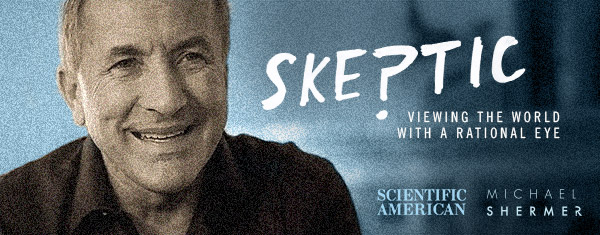
SCIENTIFIC AMERICAN “SKEPTIC” COLUMN FOR OCTOBER 2017
Sky Gods for Skeptics: Is belief in aliens a religious impulse?
In Star Trek V: The Final Frontier, Captain James T. Kirk encounters a deity that lures him to its planet in order to abscond with the Enterprise. “What does God need with a starship?” the skeptical commander inquires. I talked to Kirk himself—William Shatner, that is—about the film when I met him at a recent conference. The original plot device for the movie, which he directed, was for the crew to go “in search of God.” Fearful that some religious adherents might be offended that the Almighty could be discoverable by a spaceship, the studio bosses insisted that the deity be a malicious extraterrestrial impersonating God for personal gain.
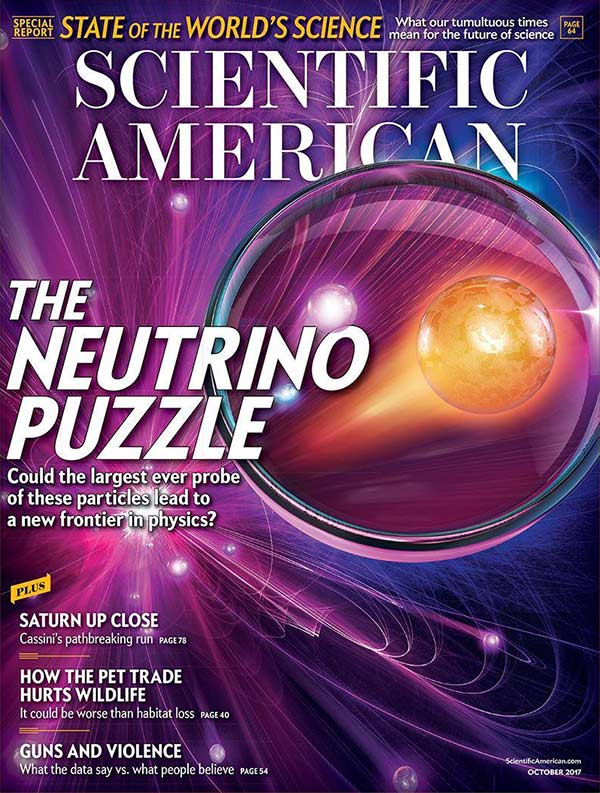
How could a starship—or any technology designed to detect natural forces and objects—discover a supernatural God, who by definition would be beyond any such sensors? Any detectable entity would have to be a natural being, no matter how advanced, and as I have argued in this column [see “Shermer’s Last Law”; January 2002], “any sufficiently advanced extraterrestrial intelligence [ETI] is indistinguishable from God.” Thus, Shatner’s plot theme of looking for God could only turn up an ETI sufficiently advanced to appear God-like.
Perhaps herein lies the impulse to search. In his 1982 book Plurality of Worlds (Cambridge University Press), historian of science Steven J. Dick suggested that when Isaac Newton’s mechanical universe replaced the medieval spiritual world, it left a lifeless void that was filled with the modern search for ETI. In his 1995 book Are We Alone? (Basic Books), physicist Paul Davies wondered: “What I am more concerned with is the extent to which the modern search for aliens is, at rock-bottom, part of an ancient religious quest.” Historian George Basalla made a similar observation in his 2006 work Civilized Life in the Universe (Oxford University Press): “The idea of the superiority of celestial beings is neither new nor scientific. It is a widespread and old belief in religious thought.” […]
American Goblins—Part 1
MONSTERTALK EPISODE 136
In August of 1955, a farm family in Kentucky found their home under attack by strange goblin-like monsters. In the years since the attack, the case has retained a perplexing endurance. What happened that night in Kentucky? Were aliens to blame? Underworld monsters? Misidentified natural causes? This is part one of our discussion of what has become known as The Kelly-Hopkinsville Encounter.

Get the MonsterTalk Podcast App and enjoy the science show about monsters on your handheld devices! Available for iOS, Android, and Windows. Subscribe to MonsterTalk for free on iTunes.
Conjuring Up a Lost Civilization:
An Analysis of the Claims Made by Graham Hancock in Magicians of the Gods
Graham Hancock’s 2015 book Magicians of the Gods: The Forgotten Wisdom of Earth’s Lost Civilization1 is something of a sequel and update to his 1995 international bestseller Fingerprints of the Gods: The Evidence of Earth’s Lost Civilization,2 which was translated into 27 languages and sold more than three million copies.3 In Fingerprints, Hancock uses creation myths in ancient texts and wild geological scenarios to suggest that 12,450 years ago major crustal shifts moved Antarctica to its present location. Portions of a supposedly highly advanced unknown lost civilization (none other than Atlantis) living on Antarctica at the time were able to survive the destructive cataclysms and go on to convey their knowledge to the builders of the megalithic structures of Egypt, Maya, Babylon, and other known great civilizations. He also claims that the Mayan calendar portended world cataclysms in 2012. In Magicians, Hancock now says he got it all wrong—there was no crustal shift; instead he thinks this advanced civilization was destroyed by a comet.
Magicians appears to be on its way to becoming another bestseller for the British writer. Although Hancock has few scientific credentials (an undergraduate degree in sociology from Durham University),4 his early career as a journalist5 helped him navigate through a wide range of scientific research, but without benefit of specialized training in astronomy, geology, history, archaeology, or comparative religion and mythology. Hancock is obviously bright, articulate, and a good writer and storyteller who comes across as eminently reasonable, which makes it all the more difficult to tease apart fact from fiction in the many claims made in his books, documentary films, and lectures.
Göbekli Tepe

Figure 1: Excavators uncover one of many circular enclosures at Göbekli Tepe. Two large T-shaped pillars over 5m (16 feet) high typically stand in the middle of the ring with smaller pillars facing them. Some of these stones are decorated with reliefs of animals that once lived in the area. This area known as Enclosure D features birds, while others emphasize animals such as snakes, foxes, boars, or wildcats.
The centerpiece of Hancock’s Magicians is a remarkable archaeological site called CONTINUE READING THIS POST…
TAGS: advanced civilizations, asterism, Göbekli Tepe, Graham Hancock, Magicians of the GodseSkeptic for September 27, 2017
In this week’s eSkeptic:

ABOVE: From the cover of Skeptic magazine 22.3: Lost Civilizations (2017)
In this week’s eSkeptic, Professor of Geology at the University of South Florida, Dr. Marc J. Defant, provides an analysis of the claims made by Graham Hancock in his book Magicians of the Gods: The Forgotten Wisdom of Earth’s Lost Civilization.
Conjuring Up a Lost Civilization
An Analysis of the Claims Made by Graham Hancock in Magicians of the Gods
by Marc J. Defant
Graham Hancock’s 2015 book Magicians of the Gods: The Forgotten Wisdom of Earth’s Lost Civilization1 is something of a sequel and update to his 1995 international bestseller Fingerprints of the Gods: The Evidence of Earth’s Lost Civilization,2 which was translated into 27 languages and sold more than three million copies.3 In Fingerprints, Hancock uses creation myths in ancient texts and wild geological scenarios to suggest that 12,450 years ago major crustal shifts moved Antarctica to its present location. Portions of a supposedly highly advanced unknown lost civilization (none other than Atlantis) living on Antarctica at the time were able to survive the destructive cataclysms and go on to convey their knowledge to the builders of the megalithic structures of Egypt, Maya, Babylon, and other known great civilizations. He also claims that the Mayan calendar portended world cataclysms in 2012. In Magicians, Hancock now says he got it all wrong—there was no crustal shift; instead he thinks this advanced civilization was destroyed by a comet.
Magicians appears to be on its way to becoming another bestseller for the British writer. Although Hancock has few scientific credentials (an undergraduate degree in sociology from Durham University),4 his early career as a journalist5 helped him navigate through a wide range of scientific research, but without benefit of specialized training in astronomy, geology, history, archaeology, or comparative religion and mythology. Hancock is obviously bright, articulate, and a good writer and storyteller who comes across as eminently reasonable, which makes it all the more difficult to tease apart fact from fiction in the many claims made in his books, documentary films, and lectures.
Göbekli Tepe

Figure 1: Excavators uncover one of many circular enclosures at Göbekli Tepe. Two large T-shaped pillars over 5m (16 feet) high typically stand in the middle of the ring with smaller pillars facing them. Some of these stones are decorated with reliefs of animals that once lived in the area. This area known as Enclosure D features birds, while others emphasize animals such as snakes, foxes, boars, or wildcats.
The centerpiece of Hancock’s Magicians is a remarkable archaeological site called Göbekli Tepe in Turkey dated to 11,600 years ago. He contends Göbekli Tepe is too advanced to have been built by hunter-gatherers alone, and must therefore have been constructed with the help of people from a more advanced civilization. Unfortunately for Hancock these people left behind no hard evidence for their existence, so he is forced to allude to what he thinks is sophisticated architecture, along with a few carved figures that he asserts represent astronomical constellations. From these speculations Hancock concludes: “At the very least it [Göbekli Tepe] would mean that some as yet unknown and unidentified people somewhere in the world had already mastered all the arts and attributes of a high civilization more than twelve thousand years ago in the depths of the last Ice Age and sent out emissaries around the world to spread the benefits of their knowledge.”
It’s a romantic notion, but not the conclusion that the late great German archaeologist Klaus Schmidt came to after excavating Göbekli Tepe for more than two decades beginning in 1994. The site, he says, was used from 11,600 to about 10,000 years before the present. Lower sections were backfilled giving way to new structures on top. The fill is refuse containing sediment, hundreds of thousands of broken animal bones, flint tools for carving the structures within the site and for hunting game, and the remains of cereals and other plant material, and even a few human bones. There is no evidence that the site was ever used as a residence, and the megaliths found there (Schmidt called them “monumental religious architecture”) along with carvings and totems, imply ritual and feasting. […]
eSkeptic for September 20, 2017
In this week’s eSkeptic:

MICHAEL SHERMER’S SKEPTICAL EYE
The founder of the Skeptics Society has devoted his career to questioning orthodoxies, from religious belief and self-help movements to the anti-scientific claims of left and right

Michael Shermer, the founder of the Skeptics Society, points to a single event in the late 1970s as his breaking point with the Christianity of his youth. The “final straw,” as he calls it, was finding himself at the hospital bedside of his college girlfriend, who had been a passenger in a van that rolled off the side of a hill, breaking her back and leaving her paralyzed from the waist down. He prayed fervently for her recovery, to no avail. “If anyone deserved to be healed it was her, and nothing happened, so I just thought there was probably no God at all,” he recalls.
His career over the past several decades has involved insistent questioning not just of religious belief but of other sorts of orthodoxy, in pop culture, self-help, science and politics. This month marks the 25th anniversary of the Skeptics Society, which is now a 50,000-member group dedicated to “promoting critical thinking and lifelong inquisitiveness.”
In his longstanding monthly column for Scientific American, Dr. Shermer, 62, has turned a critical eye on antivaccination advocates, the campus craze for condemning “micro-aggressions” and disinviting controversial speakers, and the movement to ban genetically modified crops. He has come out against both climate-change alarmists and deniers. (He tends to side with commentators such as Matt Ridley and Bjorn Lomborg, who agree that humans are changing Earth’s climate but argue that the consequences may not be as dire as doomsayers think.) In his columns and books, he has debunked everything from UFOs and claims of alien abduction to conspiracy theories about the Kennedy assassination and the 9/11 attacks.
A convert to evangelical Christianity as a high-school student in La Cañada, Calif., he went to Pepperdine University intending to become a theologian. But after taking classes in science and philosophy, he decided to study psychology instead. He later earned a Ph.D. in the history of science at Claremont Graduate University.
Unable to find a job as a professor, he went to work at a cycling magazine in Irvine, Calif. He became so interested in the sport that he started cycling hundreds of miles a week and racing long distances, with the support of corporate sponsors. In 1982, he co-founded the 3,000-mile Race Across America, which bills itself as “the world’s toughest bicycle race.”
At night, Dr. Shermer taught at Glendale Community College. He is now a presidential fellow at Chapman University in Orange, Calif., where he offers a course called “Skepticism 101.” The school is about 2½ hours from Santa Barbara, where he lives with his wife.
Dr. Shermer started the Skeptics Society in 1992 out of his garage. For the past 25 years, he has also edited and published Skeptic magazine, which he says tackles issues scientifically, questioning hypotheses and weighing research and data. “The principle is to start off skeptical and be open-minded enough to change your mind if the evidence is overwhelming, but the burden of proof is on the person making the claim,” he says. “I would change my mind about Bigfoot if you showed me an actual body, not a guy in an ape suit in a blurry photograph.”
Dr. Shermer is the author of more than a dozen books, including Why People Believe Weird Things (1997), whose targets included creationists, Holocaust deniers and believers in ESP, and The Moral Arc (2015), which argued that reason and science have made the world progressively more just.
His new book Heavens on Earth comes out in January. In it, he casts a critical eye on many religious visions of the afterlife and on the high-tech quest to evade death through such methods as deep-freezing (cryonics) or uploading memories into the cloud. “There’s no assurance that by copying every last thing in your brain, you’re going to wake up and say, ‘Here I am!’ ” he says. “You wouldn’t wake up inside the computer—you’d just be dead.”
President Donald Trump may often dismiss “fake news,” but Dr. Shermer warns against shrugging off evidence. Still, he says, “Everyone does it to a certain extent…It’s a little more heightened now because the internet is so fast to respond in real time.” Politicians have always ignored data, he says, though Mr. Trump “seems to be more bold about it than others, and that inspires others to do the same.”
Recently, Dr. Shermer has denounced both the alt-right and “the regressive left.” After the violent white supremacist protest in Charlottesville, he warned against what he calls “this whole ‘punch a Nazi’ thing,” including the actions of the controversial far-left movement known as antifa. “This is why the antifa movement is just as bad as the white supremacist movement,” he says. “They both feel they have a moral cause that’s worth dying for and worth killing for.”
In the decades ahead, Dr. Shermer expects to see more people adhering to secular philosophies and Eastern religions with stronger links to science: Meditation, he says, can clearly improve health and well-being.
He is less enthusiastic about the rise of some New Age philosophies, which he says can contain troubling quasi-religious urges toward utopianism. “There is no one answer to what makes a perfect society,” he says, and the attempt to create an earthly paradise can turn murderous, as it did at Jonestown in Guyana in 1978: “Someone is in your way, preventing you from achieving eternal happiness, and they have to be dispensed with.”
Dr. Shermer considers organized self-help movements misguided because they tend to encourage people to chase after money and a simple ideal of happiness, rather than to find satisfaction in a purposeful life.
“Most of what we do doesn’t make us happy, it makes us more fulfilled as a person,” he says. His morning bike ride, for example, wasn’t fun, he says. “It’s a suffer-fest,” he says. “It’s 90 degrees out, my lungs are screaming and my legs are screaming, but I feel better after.” ![]()
SCIENCE SALON # 15: OCTOBER 15, 2017
Donald Prothero & Timothy Callahan—UFOs, Chemtrails, and Aliens: What Science Says
UFOs. Aliens. Strange crop circles. Giant figures scratched in the desert surface along the coast of Peru. The amazing alignment of the pyramids. Strange lines of clouds in the sky. The paranormal is alive and well in the American cultural landscape. In UFOs, Chemtrails, and Aliens, Don Prothero and Tim Callahan explore why such demonstrably false beliefs thrive despite decades of education and scientific debunking.
Employing the ground rules of science and the standards of scientific evidence, Prothero and Callahan discuss a wide range of topics including the reliability of eyewitness testimony, psychological research into why people want to believe in aliens and UFOs, and the role conspiratorial thinking plays in UFO culture. They examine a variety of UFO sightings and describe the standards of evidence used to determine whether UFOs are actual alien spacecraft.
Finally, they consider our views of aliens and the strong cultural signals that provide the shapes and behaviors of these beings. While their approach is firmly based in science, Prothero and Callahan also share their personal experiences of Area 51, Roswell, and other legendary sites, creating a narrative that is sure to engross both skeptics and believers.
Order UFOs, Chemtrails, and Aliens from Amazon.
Reserve your seat(s) online or by calling 1-626-794-3119. Online reservation closes Sunday October 15, 2017 at 11am PDT.
2018 | IRELAND | JULY 15–AUGUST 2
Join us for a 19-day tour of the Emerald Isle
Ireland’s famed scenic landscape owes its breathtaking terrain to a dramatic 1.75 billion year history of continental collisions, volcanoes, and glacial assault. Join the Skeptics Society for a 19-day immersive tour of the deep history of the Emerald Isle, while experiencing the music, hospitality, and verdant beauty that make Ireland one of the world’s top travel destinations.
Dr. Nancy Segal — Twin Mythconceptions: False Beliefs, Fables, and Facts about Twins
Dr. Nancy Segal, the world’s leading expert on twins, has a new book that sheds light on over 70 commonly held ideas and beliefs about the origins and development of identical and fraternal twins. Using the latest scientific findings from psychology, psychiatry, biology, and education, Dr. Segal separates fact from fiction. Each idea about twins is described, followed by both a short answer about the truth, and then a longer, more detailed explanation. Coverage includes embryology of twins, twin types, intellectual growth, personality traits, sexual orientation of twins, marital relationships, epigenetic analyses, the frequency of different twin types and the varieties of polar body twin pairs. This book, and Salon with Dr. Segal, will inform and entertain behavioral and life science researchers, health professionals, twins, parents of twins, and anyone interested in the fascinating topic of twins and what they can teach us about human nature.
Dr. Segal earned her Ph.D. in the Social Sciences and Behavioral Sciences from the University of Chicago. From 1982-1991 she was a post-doctoral fellow and research associate at the University of Minnesota, affiliated with the well-known Minnesota Study of Twins Reared Apart. She is currently Professor of Psychology at CSU Fullerton and Director of the Twin Studies Center, which she founded in 1991. Dr. Segal has authored over 200 scientific articles and book chapters, as well as several books on twins. Her previous book, Born Together-Reared Apart: The Landmark Minnesota Twin Study (2012, Harvard University Press) won the 2013 William James Book Award from the American Psychological Association. Her other books include Someone Else’s Twin: The True Story of Babies Switched at Birth (2011), Indivisible by Two: Lives of Extraordinary Twins (2007) and Entwined Lives: Twins and What They Tell Us About Human Behavior (2000). She is the 2016 recipient of the Wang Family Excellence Award from the California State University administrators and trustees for “exemplary contributions and achievement.” She was recognized as CSUF’s Outstanding Professor of the Year in 2005 and as the Distinguished Faculty Member in Humanities and Social Sciences in 2007 and 2014. She has been a frequent guest on national and international television and radio programs, including the Martha Stewart Show, Good Morning America, the Oprah Winfrey Show and The Forum (BBC). Dr. Segal has variously served as a consultant and expert witness for the media, the law and the arts.
Order Twin Mythconceptions from Amazon.
TAGS: Science Salon, The Michael Shermer Show, twinseSkeptic for September 13, 2017
In this week’s eSkeptic:
WATCH THE LIVE STREAM THIS SUNDAY
Dr. Nancy Segal — Twin Mythconceptions: False Beliefs, Fables, and Facts about Twins
Reserve your seat(s) online or by calling 1-626-794-3119. Online reservation closes Sunday September 17, 2017 at 11am PDT.
SKEPTIC MAGAZINE 22.3
Evaluate the Evidence for a Mysterious & Advanced Lost Civilization
In the latest issue of Skeptic magazine (22.3): Debating Science and Lost Civilizations: Michael Shermer on the Joe Rogan Experience; Conjuring Up a Lost Civilization: an Analysis of the Claims Made by Graham Hancock in Magicians of the Gods; Lost Civilizations and Imaginative Conjectures; The Real Origin of UFOs and Aliens: How the Media Shaped Our Ideas About Extraterrestrials; Publicly Funded Stem Cell Research: California’s $3-Billion Experiment in Public Science; Science, Facts, and “Provisional” Knowledge; Juicing for Health or Torture; Our Angry Era; Zombies: The Gruesome True Story of Zombies…
Read Skeptic magazine on iOS, Android, Windows Phone, Kindle Fire HD, Mac, and PC. Get the digital edition instantly from PocketMags.com, or via the Skeptic Magazine App. Or, pre-order the print edition from Shop Skeptic. The print edition won’t likely hit newsstands for another week or two.
30-DAY FREE TRIAL
on new digital subscriptions on iOS & Android
We offer a 30-day free trial to new digital subscribers on annual subscriptions within the Skeptic Magazine App for iOS and Android devices.
JUNIOR SKEPTIC # 64
Zombies: The Gruesome True Story
Physically bound inside each and every issue of Skeptic magazine is Junior Skeptic: an engagingly illustrated science and critical thinking publication for younger readers (and the young at heart).
Our world has been conquered by hordes of zombies! They menace us in video games, comics, television, and movies. They lurch gruesomely down city streets in “zombie walk” events. After decades of zombie fiction, the walking dead are more popular than ever. Mindless, moaning, hungry for human flesh, zombies may be the ultimate modern monsters. They’ve spread like a virus through tales of terror and horrified imaginings. But where did the idea come from? Were zombies invented for fiction, or do they have a basis in legend—or perhaps even in reality? Could anything like fictional movie zombies actually exist in the real world?
2018 | IRELAND | JULY 15–AUGUST 2
Join us for a 19-day tour of the Emerald Isle
Ireland’s famed scenic landscape owes its breathtaking terrain to a dramatic 1.75 billion year history of continental collisions, volcanoes, and glacial assault. Join the Skeptics Society for a 19-day immersive tour of the deep history of the Emerald Isle, while experiencing the music, hospitality, and verdant beauty that make Ireland one of the world’s top travel destinations.

ABOVE: UC Berkeley, Sproul Hall Plaza, October 1 1964. Free Speech Movement advocates, including Mario Savio in this instance, speak from the roof of a police car. They remove their shoes before climbing on the car, in order to do no damage. In the back seat of the car sits an FSM leader whom the police have arrested.
Is Antifa an enemy of free speech? In this week’s eSkeptic, Raymond Barglow discusses the recent violent demonstrations in Berkeley, which purported to “fight fascism,” while fueling it instead.
Radically Wrong in Berkeley
by Raymond Barglow
Berkeley California is famous for its history of political protest. In 1949, faculty and students at the University of California opposed an anti-Communist loyalty oath imposed by the Board of Regents. In 1964, Berkeley was home to the Free Speech Movement and subsequently to resistance against the war in Vietnam. These political efforts were all peaceful — very deliberately so. In the early 1960s, some Berkeley activists had traveled to Mississippi and other Southern states to give support to the Civil Rights Movement, and they returned as advocates of Martin Luther King’s politics of nonviolence.
Although wide differences remain, it clearly is possible for us to reach through to one another, not with a fist but with an open hand.
During the Free Speech Movement (FSM), the protesting students made a point of allowing the speech of those who disagreed with them. They held that even speech deemed repellent should be countered not by disallowing that speech but by meeting it verbally with a different point of view. “Freedom of speech,” said FSM leader Mario Savio, “is something that represents the very dignity of what a human being is. … That’s what marks us off from the stones and the stars…. It is the thing that marks us as just below the angels.” This high-minded ideal has not weathered well in Berkeley in recent years. In 2017, this town, former champion of free speech, has become known instead as its enemy: those who gather here in Berkeley to express their support for right-wing causes cannot anticipate that their meetings and rallies will be allowed. Committed to shutting down such events are several small but very militant left groups: “black bloc” and “Antifa,” both of which originated in Western Europe in the 1980s, and “By Any Means Necessary,” a revolutionary organization that was founded in the United States in 1995.

UC Berkeley, Sproul Hall Plaza, February 1 2017. Protesters light a bonfire, assault police, break windows, and prevent right-wing pundit Milo Yiannopoulos from speaking. A few demonstrators then march downtown, setting more fires and damaging property.
On February 1, 2017, Milo Yiannopoulos, a right-wing media star, was prevented from speaking in Berkeley by violent activists belonging to these groups and intent on, in their terms, “stopping Fascist speech.” On the day of Yiannopoulos’ scheduled appearance, Berkeley Mayor Jesse Arreguin tweeted: “Using speech to silence marginalized communities and promote bigotry is unacceptable. Hate speech isn’t welcome in our community.” A few hours later he qualified that statement in another tweet, “Violence and destruction is not the answer,” but that scarcely corrected the first impression conveyed to the world: across the political spectrum, the mass media condemned the “bigotry” and “hypocrisy” of Berkeley’s far left. An article in the liberal-leaning Huffington Post pointed out that Berkeley had gifted a propaganda victory to the right:
The violence at the UC Berkeley campus Wednesday night which cancelled the speech of alt-right provocateur Milo Yiannopoulos is such a debacle for the national opposition to Trump that it almost defies belief…. At exactly this moment, because of what happened at Berkeley, the Trump regime gets to present itself as the guardian of free speech in America. […]
DO YOU VALUE WHAT WE CREATE?
The Skeptics Society is a US 501(c)(3) nonprofit organization that operates on your generous patronage. If you enjoy what we create (magazines, videos, websites, salons, debates, events, etc.), please show your support by making a donation online, by mail, or by phone at 1-626-794-3119. All donations are tax-deductible.

